| |
Russian Revolution's Forum
E-books World history, Rus' history and Religions history

Modernization of Russia
Holy Russia - Third Rome
The new subject of international law, the State Holy Russia - Third Rome, 21.09.2013. | Nova Church of Holy Russia
Orthodoxy and Christianity require reforming and release of heresy and obscurantism. 21.09.2011. | Ethnopolitical transformation of Russia New!!!
The author investigates the deep ethnic and political processes occurring within Russian society. Russian statehood and the people are at a historical crossroads. The path chosen by the authorities leads to a dead end of a renewed Kyrgyz Khaganate. The alternative will allow the Russian people to achieve a European renaissance and rid themselves of barbarism and savagery. 08/26-09/06/2025. | The Seljuk Dynasty Origin New!!!
The author put forward a hypothesis according to which the Seljuk’s Sultans came from the Princes of the Russ – Rurikovich Kin, who eventually converted to Islam. The hypothesis was fully confirmed by the identification of the main historical figures of the Seljuk dynasty with the descendants of the Princes St. Vladimir and Yaroslav the Wise. We are talking about the rulers of Sultanate of Rum Sultan Suleiman and his descendants, as well as Tuqaq, Seljuk, Mikail, Israel, Toghrul, Alp Arslan and other Sultans. Princes and their sons from the Principality of Tmutarakan became Seljuk’s Sultans, from where they conquered the countries and peoples of the Caucasus, Iran, Asia Minor and Central Asia. 24.05–12.06.2023. | Synchronization of historical and religious Chronicles
The author correctly synchronizes historical and religious Chronicles of the Ancient World based on a short chronology and linking events to unique celestial phenomena reflected in the annals and Scriptures. The author believes that discrepancies in dates, geographical localities and ethnic origin of historical and religious figures are due to erroneous traditional chronology and historical geography, as well as the deliberate adaptation of phenomena and events to an established paradigm. 20.04–25.05.2020. | Astronomical dating of Biblical events
The author's reconstruction of the history and chronology of religions is fully verified by identifying 15 celestial phenomena described in the Chronicles, including 11 Solar Eclipses, 3 Zodiacs and 1 Supernova. A chronological shift of 1780 years in the history of Ancient Egypt has been confirmed for 6 phenomena, including 3 Solar Eclipses and 3 Zodiacs, including the Eclipse of Pharaoh Takelot on August 8, 891. Astronomically confirmed the date of the Crucifixion of Jesus Christ as March 18, 1010, and the date of death of Ibrahim – the son of the Prophet Muhammad as February 7, 1152 (28 Shawwal 546 AH). 20.02–31.03.2020. | Origin of the gens Rurik
After the break of ties between the metropolis and the Russian principalities, the annals of Byzantium were cleared of the mention of "foreigners" in the management of the Empire, and the Chronicles of Russia did not have time to properly reflect the role of Rurik in world history. A study of the sources of Ancient Rome, New Rome, Russia, Arab countries, Danube and Volga Bulgaria allowed the author to identify the Russ gens and Bulgarian Khagans with the Flavian dynasty, as well as to identify Rurik, his descendants and relatives from the Macedonian dynasty (IX–XI century) and dynasty of Lecapenus (X century). The last Russian Emperor of New Rome been Yaroslav the Wise, throne name Constantine Monomachos. 11.09–21.10.2019. | Chronology of monotheistic religions
The author identified the Patriarchs of monotheism with well-known figures of human history. He proved that the oldest religion of monotheism is Christianity, which had a theoretical character in the I Millennium (Old Testament Christianity) and a practical embodiment at the beginning of the II Millennium (New Testament Christianity). Islam and Judaism emerged only in the early VII century and became radical branches of Christianity. Based on the study of solar eclipses, the author has determined the date and place of the Crucifixion of Jesus Christ (March 18, 1010 in Constantinople), the year of the death of the Prophet Muhammad (1152) and the period creation of the Quran (1130–1152). 01–27.08.2019. | Localization of Ancient Rome
The history of Ancient Rome is well studied, but hides a lot of inconsistencies and contradictions relating to the period of formation of the city and the expansion of the Romans into the world. We believe that the problems are caused by ignorance of the true localization of Ancient Rome in the Volga region on Akhtuba until the Fire on 64 and move city to location of Veii in Italy. The article also considers the aspects of ethnic origin of the peoples of the Latin League, Ancient Rome and Europe. The vector of expansion of Ancient Rome from the Volga region to the Europe coinciding with the migration flows of the Migration Period and the spread of PIE is substantiated. In addition the article considers the dynamics of growth and decline of the population of Ancient Rome in the localities from its inception to sunset and transformation. 23.06–16.07.2019. | Short chronology of Ancient Egypt
The history of Ancient Egypt generated in XIX century, every day finds out all greater discrepancy to modern realities both the newest archeological and tool data, including results of DNA researches of mummies of the Egyptian pharaohs. The chronology of Egypt as whole is considered well investigated and however it has been created for substantiation of an antiquity of Jewish people, instead of for scientific description of one of most ancient terrestrial civilizations. Author's reconstruction of chronology of Ancient Egypt has found out time shift at rate 1780 years in depth of centuries from true dating events. 1-16.06.2019. | Great Tartary or Slavic Empire
The next riddle of world historiography is solved. Present clause is devoted to history and modern condition of one of the most grandiose empires of terrestrial civilization – Great Tartary or Slavic Empires. 04–19.09.2017. | The European Aryans
In present clause the broad audience of the questions connected to probable Aryan origin of various European peoples is considered. Including aspects of possible an Aryan origin of Slavs and prospects of presence by these of special way to world around are considered. 25.02.2017 - 24.03.2017. | Summarizing of Zemsky Sobor 2016 (Land Assembly 2016)
Within the framework of carrying out Zemsky Sobor 2016 (Land Assembly 2016) on elections of Grand Prince of All Russia four Nominees have been put forward. The overwhelming majority of voices have been given for Nominee Grand Prince Valeriy Viktorovich Kubarev. Will of God and decision of participants of Assembly, Zemsky Sobor 2016 has elected lifelong Grand Prince of All Russia Valeriy Viktorovich Kubarev Grand Kubensky Rurikovich. 11.05.2016. | Yaroslavl’s Princes Rurikovich
In clause is described family tree of Grand Princes of Yaroslavl and their descendants, it is the senior branch of the Kin of Russ – Rurikovich, going back to Mstislav Great Monomachos. Kin of the Grand Princes of Yaroslavl have continued by Princes Grand Kubensky – Kubarev. 22.02.2016–11.03.2016. | All truth about Saint Prince Vladimir
In clause the all truth about Saint Prince Vladimir which is ignored Orthodox and Romanov’s historians, communistic historical science and their modern adepts, fabricating myths about Russ with « good intentions » opens without denominations. The kin of Russ - Rurikovich has created Orthodoxy and the Russian statehood, Russian people began to forget about it. Glory to Russ! 07-17.07.2015. | Brief chronology of religions
The report at XXX International conference on problems of the Civilization, 25.04.2015, Moscow, RosNoU. In the clause the final Chronological Tables of Ancient Egypt, Ancient and New Rome, Rome in Italy, Christianity, Islam and Judaism are submitted. 25.04.2015. | Canons of Orthodoxy of XIV century and the present time
The report at XXIX International conference on problems of the Civilization, 20.12.2014, Moscow, RosNoU. In the report the comparative analysis of canons of Orthodoxy of XIV century (1315-1321), displayed on mosaics and frescos of Church of Chorus in Istanbul, and modern doctrines are made. Numerous differences of events of the Holy Legend and the Gospel of the past and the present are found out. 20.12.2014. | Ethnic threats to peoples of Russia
In clause political, economic, cultural and religious aspects of consequences of ethnic opposition of radical peoples of Russia and new coming Slavic population formed as result of violent Slavic expansion in Russia in days of the Mongolian yoke are considered. The historical reasons of occurrence of ethnic contradictions are investigated, estimations of modern condition of problem (Chechelevskaya and Lubotinskaya Republics in 1905, Donetsk national republic and Lugansk national republic in 2014 in territory of Ukraine) are given and offers on decrease in escalation of ethnic opposition in territory of Eurasia are made. 09.06 - 05.07.2014. | Attribution of Rurikovich and Emperors Lecapenus
The report at XXVIII International Conference on problems of the Civilization is 26.04.2014, Moscow, RosNoU. In clause it is described detailed attribution of Ugrian Tsars with Emperors of Ancient and New Rome and Patriarches of terrestrial civilization. It is scientifically proved origins of all patriarches of monotheism and Emperors Flavius and Lecapenus from kint of Ugrian Tsars of Russ (Great), is the ethnic Finn-Ugrian from Volga region. 23.03.2014 – 24.04.2014. | Putin's Eurasian impasse
Vladimir Putin and Uniform Russia realize the Eurasian project, involving Russia and Russian people during stagnation and backlogs from World Civilization. They create Gog and Magog Empire, menacing to world peace. Why the Kremlin authority has not asked Russian Slavs – they want to live in the Asian country or to be safe Europeans? 14-22.01.2014. | Projections of the God in symbols of religion
As result of studying the extensive visual material created by 3D modeling, we have proved existence of uniform source of an origin of Projections of the God, that is religious symbolic of people. The source or quantum object refers to the Chariot of the God. We believe that on the basis of our researches, it will be possible to organize training to travel on the Universe of space navigators from the most gifted people and to create spaceships with engines as the described quantum generator is Chariots of the God or the Chariot of Cube. 25–30.08.2013. | Origin and migration of Slavs
Historical and genetic routes of migrations of the Slavs, calculated with the help from ancient Byzantium, European, Chinese, Arabian, Bulgarian and Russian chronicles and annals, and also modern researches of man's DNA chromosomes. 01-21.05.2013. | Empires of cousins of Russ
The report at scientific XXVI International conference on problems of the Civilization 26-27.04.2013, Moscow, RosNoU. In article five world Empires of cousins of Russ (Great) existing in our era on open spaces of Eurasia with cyclicity of occurrence once in 300 years are described. | Hungarian Kingdom of Russ
It is continuation of research of dynastic communications of Rurikovich. Cousin of Rurik Almysh/Almos and his children Kazan/Kurszan and Arbat/Arpad, it is all ethnic Ugrian of Russ, have based at the end of IX century – beginning of X century the Hungarian kingdom of Russ, having grasped Great Moravia. 08-11.01.2013. | Reconstruction of dynastic communications of Rurikovich in IX-XI centuries
Report at anniversary scientific XXV International conference on problems of civilization at 21-22.12.2012, RosNoU, Moscow. Corrected at 03.01.2013. | Educated Christianity of Russ
Bible – the Old Testament and the New Testament has exhausted itself. Forged the Scripts and the Sacred Legend cannot serve more as a spiritual reference point for promotion of mankind forward on the river of time. It is allowable to use only spiritual – moral potential of the ancient products being product of national creativity of Jews and Catholics, instead of divine revelations. The chronology of Bible events, an ethnic accessory of patriarchs of mankind, names, geography and original languages of heroes of the Bible do not correspond to the validity. Bible miracles have the quantum nature in the basis and submit to laws of a universe. Educated Christianity of Russ restore the religious both destroyed obscurantists religious and scientific knowledge of Christianity and revolutionary role of religion in history of civilization. 26.08. – 12.10.2012. | True Empty Tomb
Nova Church of Sacred Russia and Sacred Russ, Princes of Russia congratulates mankind on presence of True Empty Tomb and restoration of the religious and historical truth. The true has triumphed forever. 20-29.05.2012. | Orthodoxy and Islam in Old Russia
The report at XXIV International scientific conference on problems of the Civilization in Russian New University on April 20-21, 2012. | Day of Church Slavonic writing. Russ Cyril and Methodius.
In this significant holiday of Day of Church Slavonic writing and remembering Equal Apostles Sacred Cyril and Methodius, Princes of Russ convincingly ask Russian Orthodox Church and the public of the orthodox countries to return to sources and correctly to name the writing, language and church books Russian, but not Slavic. Ancient Russia was the Finno-Ugric state created by Russ Christians Rurik and Igor, Cyril and Methodius, Askold and Dir, Prophetic Oleg and Sacred Olga, Sacred Vladimir and Empress Anna Macedonian.
24.05.2011. | Wars of Russ in IX-XI centuries
In article on a rich actual material it is shown, that all wars of Russ with Byzantium in 836-1043 have been connected to deduction of a throne of empire by Russian party of Constantinople headed by the Macedonian dynasty of Russ. To the author it is proved, that two centuries co-emperors of New Rome were Great Princes Rurikovich. Last Russian emperor Jaroslav Mudry known in Tsar Grad as Constantine Monomakh was. The report at scientific XXII International conference on problems of the Civilization 22-23.04.2011, Moscow, RosNoU. | Genetic distances between cousins Rurikovich
The report at scientific XXII International Conference on problems of the Civilization, on April 22-23, 2011, RosNoU, Moscow, Russia. 24.04.2011. | Slavic-Mongolian invasion to Russia
Results of our research of an origin of Slavs have not simply scientific, but political value. In view of the received data it is necessary to form the weighed policy of interethnic and inter religious attitudes in Russia and the world. The modern hobby of Russian Slavs Rodoverie, the Aries origin and the contemptuous attitude to inhabitants of Central Asia, Caucasus, Mongolia, China and other regions of the world bears a system and logic mistake. Rodoverie in general it is senseless, in fact ancestors Rodoverian in Russia and Ukraine have left Central Asia and were Kirghiz, Altaian’s, Tajik’s, Pashtun’s, Uyghur’s and Juan-Juan, and completely not blond demigods. 12-18.03.2011. | Old Rome and Italic union of the Volga region
The scientific article on an extensive historical material proves that Ancient Rome has been created by Finno-Ugric tribe’s of Italic union of the Volga region (Idel, Bulgar). Italic peoples Vestini (Vesi), Marsi (Merya), Lucani (Lucane), Marrucini (Marri) and others till now live on Volga. Finno-Ugric named Latinas (Latinyanami) German peoples of the Volga region, differently Altyn-ami that means Gold literally. Fortress Alba Longo was called Altynbash, and Volga region Rome – Ulak-Urum. Southwest capital of Finno-Ugric of Idel was city Phanagoria or the Finn–Ugoria, being in antiquities capital Bosporus Empire and Great Bulgaria was. The web of lies of the western falsifiers of history how many would not be twisted, but to it all the same there comes the end. 10-21.02.2011. | Correct genographic
We have proved fidelity Bulgarian theory of an origin of mankind. She proves to be true a natural vector of moving of people on a planet from the Volga region in all parties of Eurasia, and there from to Africa, Australia and America. All peoples and races of the world have taken place from Hindi-European, namely – from ethnic Finno-Ugric. 01-07.02.2011. | Correct DNA-Genealogy and glottochronology
Scientific article of Grand Prince Valeriy Kubarev on DNA-Genealogy and glottochronology is submitted to your attention. The author has created formulas with which help it is possible to define precisely time of life of the general ancestor and an epoch of formation of various languages. These formulas have received the name of Kubarev’s formula. With the help of mathematical calculations, Valeriy Kubarev has proved fidelity Barrow of Hypothesis of Maria Gimbutas and own reconstruction of a history of the world. We hope that results of research will find wide application in DNA-Genealogy and glottochronology. 04-14.01.2011. | Genealogy and genetics of Princes of Russia
The report of Grand Prince Valeriy Kubarev at XXI International Conference on problems of the Civilization 25.12.2010. Valeriy Kubarev's scientific article describes genetics of Rurikovich and Sorts of Russia. Grand Prince has scientifically defined modal haplotype of Rurik, Gedimin, Russ Aydar, Kubrat, Flavius and has theoretically described modal haplotype of Alexander Great, Jesus Christ Zlatoust, Prophet Mohammed and Genghis Khan. All these well-known people ethnically Finno-Ugrian from the Sort of Russ. 25.12.2010. | What do we celebrate on November 4? Loss of the national sovereignty...
National voting or voting of national representatives is unacceptable for elections of Tsar and Grand Duke, in fact tsar from the God, and the voice of people is not a voice Divine. Elections of Grand Duke only voting of Princes – patrimonial aristocracy of Russia are possible. 08-21.11.2010. | Turn of the Earth promptly comes nearer
This is article with the analysis of abnormal geophysical and climatic activity on a planet. 09-12.09.2010. | Baltavar – a symbol of Christianity, an Islam and Judaism
Petrarca: « When people will address to the history, his greatness come to live »
30-31.03.2010 | History of Russ about 3506 BC till 2012
Kubarev V.V.'s report, History of Russ about 3506 BC till 2012.
Section «Civilization aspects of the Russian history and chronology».
Tenth International scientific conference «Civilization of knowledge: global crisis and an innovative choice of Russia», Moscow, April 24-25, 2009, RosNOU. | Archive 2006-2018 |
Whose fault is it?
The Catechon Paradigm as an instrument of the Antichrist New!!!
In the article, the author examines the current state of the catechon paradigm and the practice of using the provisions of the concept in the political and public life of the Russian Federation. According to the author, the idea of the catechon in Russia was intercepted by the forces of evil and used as a screen to cover their deeds. Today, the catechon paradigm has become an instrument of the Antichrist and his adherents to gain world domination. The only resource for Lucifer’s conquest of the world is sinful people whom he can attract under his banners. As successful as his deception and seduction will be, so strong and numerous will be the army of Satan. 05–17.12.2022. | Impairment of Orthodoxy New!!!
In the article, the author has carried out a retrospective analysis of the events and processes that led to the impairment and transformation of the canons of Orthodoxy and the patristic tradition of Russian Christianity. Prohibitions and reliance on the good intentions of opportunists within the body of the church led to a natural distortion of the teaching. As a result, the Orthodox Church became vulnerable to the pressure of Lucifer's lies and deception and ceased to be a source of life. 30.09–25.11.2022. | Features of Christianity in Cappadocia New!!!
The usual facts for Cappadocia were the proximity of male and female Monasteries and their communication. The plots and frescoes of the Churches were created no earlier than the first quarter of the XI century. The isomorphic images of St. George, Theodore Stratelates and Theodore Tiron have come down to us. According to the author, St. George became a collective image of the Saints Constantine the Great and the two Theodores. The fresco of the Serpent Church depicts Onuphrius the Great as a hermaphrodite, which the Church is trying to forget. On the face of the purposeful distortion by Christianity of the Holy Tradition, led by the Holy Spirit, and the removal from the original sources. 05–28.08.2022. | Emperors Lekapenos(920–945)
Based on a thorough analysis of the chronicles of New Rome, Ancient Russia, Great Bulgaria and Arab sources, the author has justified the Finno–Ugric origin of the Macedonian Dynasty and the Lekapenos Dynasty. The details of the biographies, names, dates of rule and family ties of dozens of Emperors, Khagans and Princes of Byzantium, Russ and Bulgar coincide with great accuracy, which makes it possible to identify all the studied personalities with real historical figures. In local chronicles, they have different or identical names, depending on the national characteristics of the nicknames of the studied persons. 07.12.2020–30.01.2021. | Dancing on bones (people losses of USSR in SWW)
We have found out the facts of direct falsification of human losses of military men and civil persons of the USSR within the Second World War in some millions person. Forgery is caused by activity of the propaganda machine of the USSR and false understanding of patriotism in modern Russia. By our calculations true irrevocable losses of the population of the USSR within the SWW make 7.6–8.7 million persons from among military men and the general losses with civil people 12.8–13.9 million persons. Have run away from Stalin paradise of USSR is hundred thousand (up to 1.3 million) the persons. We believe that the name of each victim of war should be taken into account and sounded publicly. 04–18.05.2019. | Expansion of Rome from Volga region
The report at XXXIII International conference on problems of the Civilization, 24.12.2016, Moscow, RosNoU. In the report the extensive information on resettlement of peoples to Europe through ports of Bosporan Kingdom and Bosporus to the Mediterranean from the Volga region, Siberia and Caucasus during existence of Ancient Rome in delta of the rivers Volga and Akhtuba since VI century B.C. up to middle of VI century is submitted. 24.12.2016. | Seleucus and tribal leaders of Rome
The report at scientific XXXI International Conference on problems of the Civilization has acted on December 26, 2015, RosNoU, Moscow, Russia. In the report the hypothesis that "Macedonian" gains of IV century B.C. actually are the first wave of expansion of Ancient Rome and resettlement of peoples on South, East and West from territory of the Volga region and Caucasus is put forward and proved. 26.12.2015. | Picturesque Gospel of Church of Chora (Kariye) in Istanbul
Research of artifacts of Church of the Christ Savior in Chora (Church of Chorus, XIV century, Istanbul) has allowed restoring overlooked nuances of ancient doctrines of Byzantium Orthodoxy. The numerous facts of distortion Holy Book and Holy Legend have been found out at formation of modern Christian canons which at all are not an inviolable reality from above, and there is product of human creativity. 15.09–08.10.2014. | Images ancient Romans from Volga in artefacts
Long millennia in Idel-Rome-Memphis-Mitsraim-Itil-Saray-Batu lived from 600 000 up to one million person. Ruins of city are grandiose pantry of a history, culture and religion. Masonic scientists diligently avoid carrying out there scale excavation. In those places prospers only black selector of treasures. How long it is possible to hide to world elite of impostors true from people? 20-22.04.2010. | Archive 2004-2018 |
What to do?
Sixth and other questions New!!!
Why doesn't the ROC want to stop the war? 14.02.2022. | Five questions to the ROC New!!!
The first question: What is the data of the Birth of Christ now?
The second question: When and where was Jesus Christ crucified?
The third question: When will the Apocalypse begin?
Fourth question: Why Tartarus and the Kingdom of The Beast located in Russia?
The fifth question: When did Vladimir Putin become the receptacle of the Beast? 24-27.01.2022. | The Prophet Muhammad and the Quran
Based on an independent analysis of artifacts, ancestral tree and astronomical phenomena related to the deeds, life and death of the Prophet Muhammad, as well as historical evidence of the first appearance and legal use of the Quran in the life of Muslims, the author drew conclusions about the integration of several historical figures of the VII and XII centuries into the personality of the Prophet Muhammad. They became Khagan Kubrat, aka Emperor Heraclius, the Arabian Prophet or Caliph of the Rashidun Caliphs and the true Prophet Muhammad, who lived in 1090–1052. The Quran was created in 1130–1152. The proposed interpretation does not undermine the canons of the faith of Islam, but establishes the truth. 11–30.11.2021. | Syncing the chronicles of Rome and Egypt
Based on a thorough analysis of details of military campaigns and astronomical phenomena from the chronicles of Ancient and New Rome, Ancient Egypt and Persian sources, the author confirmed the chronological shift in the history of Ancient Egypt by 1780 years in the past. The author also revealed the complot of historians to conceal the existence of Ancient Egypt in I millennium by masking the deeds of the Egyptian Pharaohs of the New Kingdom for the non-existent activity of the Kings of the Sasanian Empire. 06–29.03.2021. | The identification of the Patriarchs with historical figures
The author correctly identifies the Patriarchs of monotheistic religions with historical figures of the past based on the paradigm of a short chronology of the world and linking events to unique celestial phenomena reflected in Chronicles and Scriptural. The identification of the Patriarchs is based on the analysis of data from the genealogical trees of Jesus Christ from Lucas, Matthew, mosaics of the Church of Chora, the genealogical tree of the Prophet Muhammad and lists of the Kings of the Great Bulgaria. 21.07–27.08.2020. | Pure Relationship
We have found out and have proved that at everyone men are two direct lines of Pure Relationship on which in each generation of ancestors he has only one pair pure relatives – the forefather and the foremother. All other ancestors are the listed relatives. We also have proved that each woman has two direct lines of Pure Relationship on which in each generation of ancestors it has only one pair foremothers. On the basis of research we confirm De Facto firmness of the absolute law of succession is rule Lex Salica of Pure Relationship. 05.08 – 03.09.2014. | Archive 2004-2018 |
To be continued...
Thoughts aloud: Religion
Thoughts aloud: Politics
Thoughts aloud: Advice
Thoughts aloud
To be continued...
|
|
|
|
Valery KUBAREV > Modernization of Russia > Chronology of monotheistic religions
Chronology of monotheistic religions |
Kubarev V.V., Chronology of monotheistic religions, East European Scientific Journal (Warsaw, Poland), #8 (48), 2019 part 6. Pp. 31–67. Link: https://eesa-journal.com/wp-content/uploads/EESA_august_part6.pdf | Summary: The author's research of chronology and history of Ancient Egypt and Ancient Rome confirmed the Kurgan hypothesis of Maria Gimbutas about the origin of mankind in the region of the Volga and the Southern Urals – Yamnaya culture, as well as the expansion of Earth civilization from this area. In the present clause on the basis of extensive material studied of the personality of the Patriarchs of mankind, proved Ugric origin thereof and clarified the chronology of the religions of monotheism for the period from the Flood – Late Bronze Age collapse (1250–1200 BC) to the present day. The author identified the Patriarchs of monotheism with well-known figures of human history. He proved that the oldest religion of monotheism is Christianity, which had a theoretical character in the I Millennium (Old Testament Christianity) and a practical embodiment at the beginning of the II Millennium (New Testament Christianity). Islam and Judaism emerged only in the early VII century and became radical branches of Christianity. Based on the study of solar eclipses, the author has determined the date and place of the Crucifixion of Jesus Christ (March 18, 1010 in Constantinople), the year of the death of the Prophet Muhammad (1152) and the period creation of the Quran (1130–1152). Key words: chronology, monotheism, Christianity, Islam, Judaism, Patriarchs, Ugric peoples, Abraham, Moses, King David, Jesus Christ, Prophet Muhammad, Volga region. Statement of problem: Chronology of the patriarchs of the monotheistic religions in the process of development of science and accumulation of knowledge about history and archaeology, more and more are legendary, not the actual character. They are not the result of an analysis of historical events and personalities, nor are they the result of instrumental studies of artifacts such as the radiocarbon method, archaeology, DNA genealogy, and PIE theory. However, we are convinced that the formation of monotheistic religions and the actions of the patriarchs of mankind have a real basis, lying in the layers of historical events and personalities of the past, therefore, possible binding and identification thereof. The analysis of the last of research and publications: Research topic history of religions and of the lifetimes of the patriarchs of Christianity, Islam and Judaism is well-established character, when seriously discussed, only minor deviations from the accepted canons of several years, radically altering the historical fabric and the geographical scope of religious events and the ethnicity of the patriarchs of the monotheistic religions. Allocation unresolved before parts of the general problem: Author's researches and reconstruction of chronology and geography of Ancient Egypt, and also Ancient Rome, show fallacy of the stereotypes accepted by society. The paradigm of the emergence of modern civilization in Africa contradicts the logic of historical events, archeology, PIE theory, DNA genealogy and the vector of the Migration period of people from the Caucasus and the Volga region. The lack of artifacts discovered in Palestine the older than I century and genetic studies of mummies of the New Kingdom Pharaohs of Egypt proved a complete failure of the traditional historiography and the history of religions. These contradictions require correction of mistakes and establishment of truth. The purpose of clause: The purpose of this study is to establish the true chronology of monotheistic religions and the identification of the patriarchs of mankind with famous historical figures of the past, taking into account the correct geographical reference of events, the PIE theory, DNA genealogy and the vector of the Migration period of people. The basic material: To achieve this goal, we will use the paradigm of the emergence of modern human civilization in the Volga region about 5500 years ago. For the first time such a hypothesis was put forward by Maria Gimbutas in 1956 [1–4]. In the author's research in 2009, we confirmed this theory, tying it to the canvas of historical events of the past [5], and also clarified the chronology and localization of Ancient Egypt and Ancient Rome [6, 7]. In the framework of our reconstruction of the Flood corresponds to the period of the Late Bronze Age collapse (around 1244 BC), and the date of birth of the Patriarch Abraham, he also Ugric Khagan the Tash Bash [5, 8], also known as the Emperor Titus Vespasian Flavius are 7 or 9. From these premises and information Septuagint by simple calculations can determine date of birth of Adam (3506 BC) and other Patriarchs.
If following the periods of life of the Biblical Patriarchs from the date of the Flood to the generation of Abraham (the birth 180 BC or 7/9) leads in our reconstruction to the emergence of a chronological gap of 189 years. This phenomenon is caused by the presence of any one generation unaccounted for or underestimated by the dates of birth of the children of Nahor and Terah.
The results of our reconstruction of the ancient history and chronology of monotheistic religions are summarized in Table No. 1. The first column is the serial number of historical figures, including Patriarchs, Pharaohs, Kings and Emperors of Rome, Patriarchs of Islam and Ugric Kings. The second column is the numbers of the Pharaohs on the Abydos list. This is followed by a column of known names of Pharaoh. The fourth column is the Roman names of Pharaohs, Emperors or Kings, as well as the years of their board. In the fifth column indicate information about significant events that occurred during the reign of the Pharaoh or King. In the sixth column we will indicate the names of Biblical and Islamic Patriarchs and the years of live. In the last column we will write the names of the Ugric Kings, the current number, as well as the duration of their life and board. Light gray background in the fields of the table we note the coinciding historical and Biblical personalities, and a darker gray background – the identified personalities of Pharaohs, Kings, Emperors and Patriarchs.
| 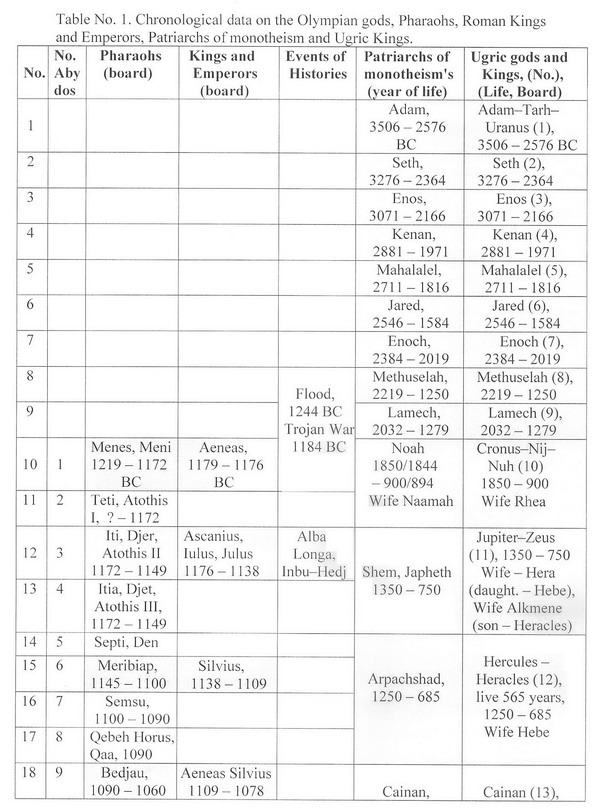
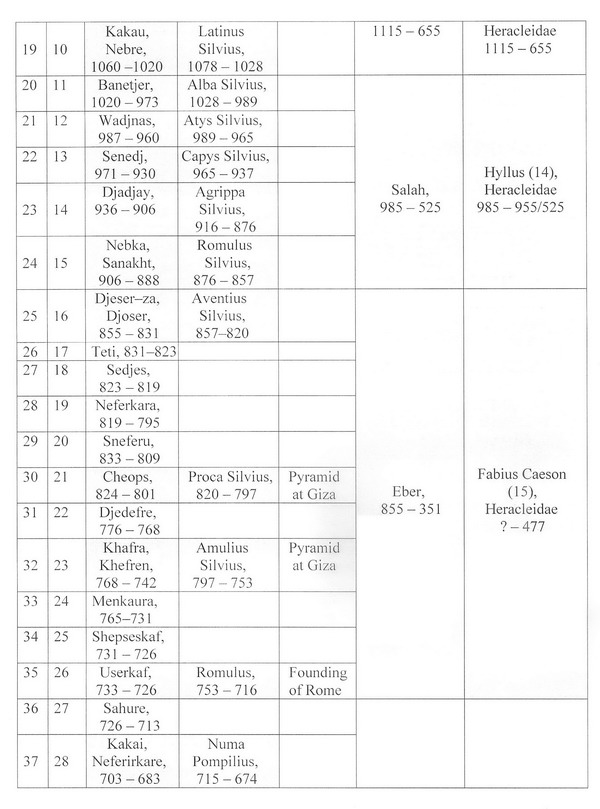
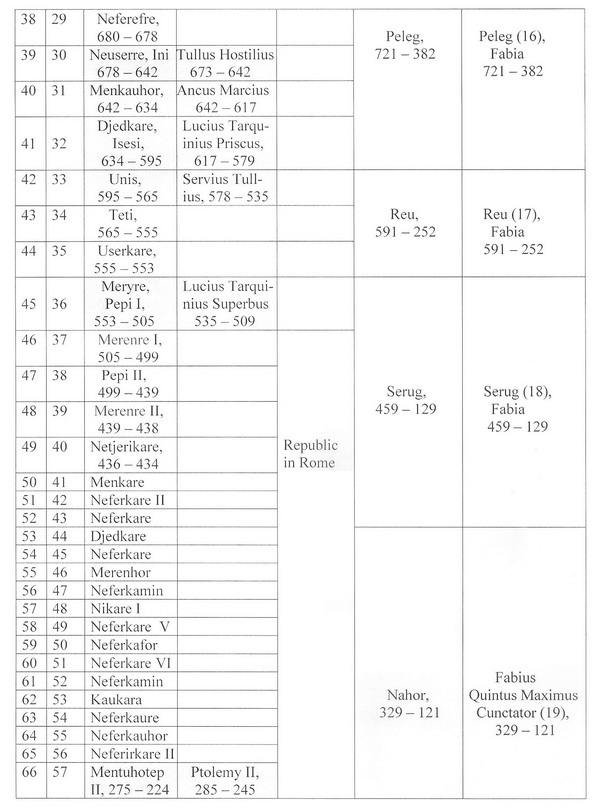
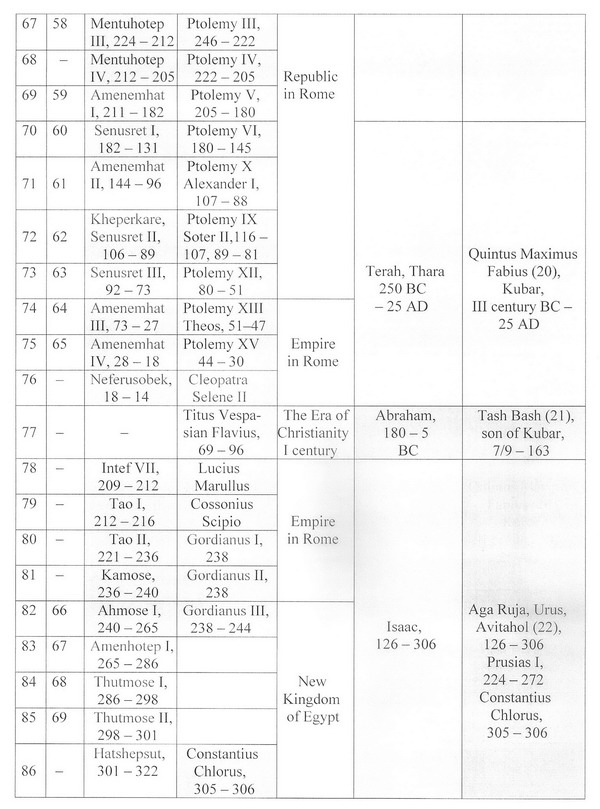
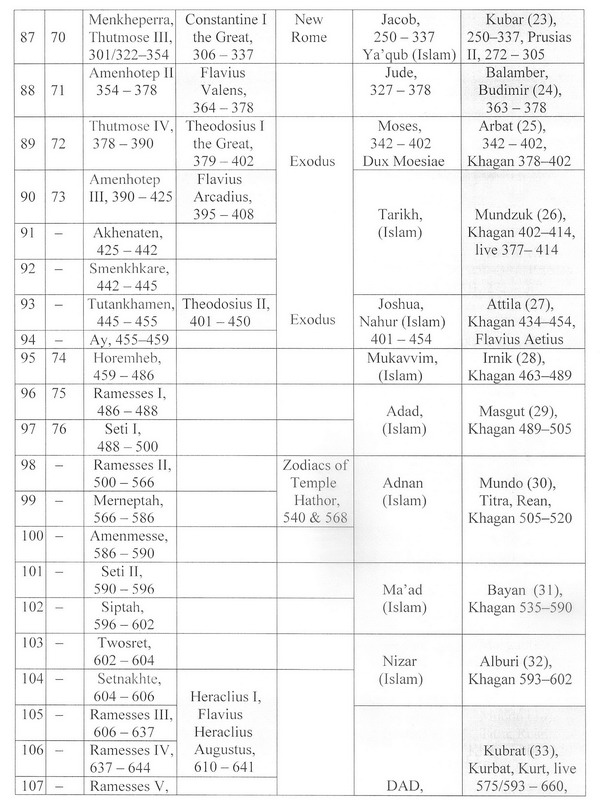
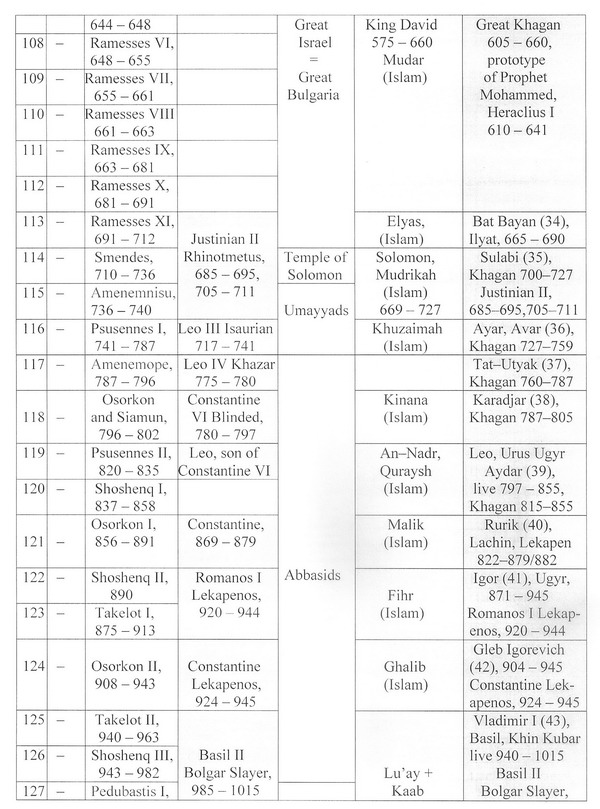
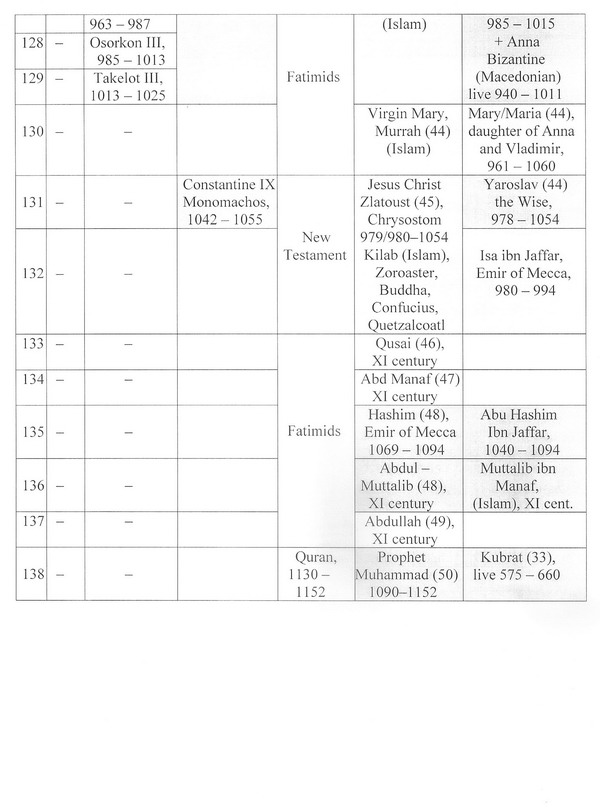
| According to our reconstruction, the Patriarchs and the Kings from Titus Flavius Vespasian are ethnic Ugric Haplogroup N1. Therefore, the early Patriarchs down to Adam are ethnic Ugric peoples, including gens Fabii and Heracleidae, as links in chain of family tree. The history of mankind before the Flood of the XIII century BC is covered with darkness and before beginning of our era is legendary. More or less confidently, we can analyses the events and facts of the past two Millennia.
Biblical Patriarchs of the early period were gods for the human race. They created their harems, where dozens or even hundreds of children were born, who lived a normal life of several decades. Sometimes the family of the Patriarchs was born regular people with pure genes and special powers that lived many hundreds of years. After the Flood the gods of the Olympic Pantheon became the incarnations of God for the peoples of the Mediterranean, Caucasus and Volga region. In the article about Ancient Rome we have shown that names of gods of Etruscans, Romans and Greeks have an origin from the Volga region [7]. We are talking about the gods and goddesses Tinia, Uni, Quirinus, Turan and others. Indeed, the first Ugrians created their civilization in the area of Yamnaya culture (the Volga region and the Southern Urals), so it is natural to consider the Biblical Patriarchs as Ugrians, but not Semites.
According to our reconstruction [5], God the Father created in Volga region the harem consisting of 7 wives who gave birth to 12 children – 10 boys and 2 girls. His wife was a female hominid without a soul from different regions of the Mediterranean and Black Seas. This hypothesis is confirmed by the genetic studies of Brian Sykes on the origin of mankind from one Forefather and seven Foremothers [9]. A similar scheme of formation of mankind was depicted by the Egyptians on the bas-relief of Aton with seven Foremothers in the tomb of Ramses VI in the Valley of the Kings. Mothers are the first people of different Nations called by different names like the Pleiades, Berehynia, Frigg, Subaru, etc. the First couple of mankind was formed by Adam and Eve, they are Tarh and Tara, Uranus and Gaia. The original men formed ten Royal families and their own tribes, which were formed from the children of harems of female hominids. Males without a soul were destroyed or taken into service. Hominid without a soul in Bulgarian Chronicles was called Ubiri [8]. As result of the mixing of people and hominids on Earth appeared modern humanity, consisting of the Royal families of Ugrians and other ethnic groups that survived the conquest of planet by children of God Father. All new people from mixed marriages began to have soul and innate religiosity.
| 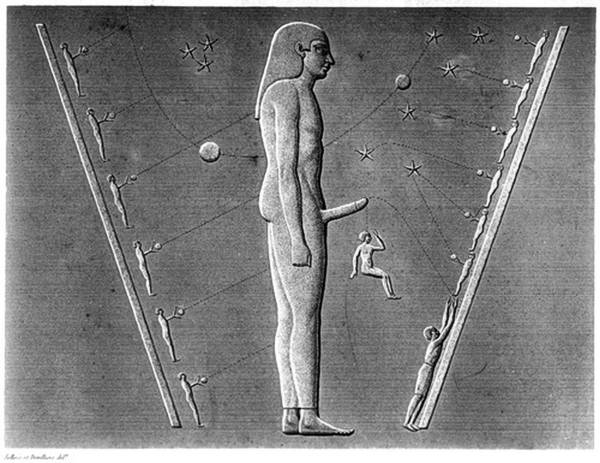
Bas-relief of Aten with seven foremothers in the tomb of Ramesses VI in the Valley of the Kings
| The most advanced ethnos of people after the Flood were the ancestors of the Germans – Europeans, Haplogroup R1b, place of origin is the Volga region and the Southern Urals. One of them is King of Dardanians the Aeneas – Menes after the defeat in the Trojan War in 1184 BC created a unique civilization in two remote regions of Upper Egypt in Africa on the Nile and Lower Egypt on Akhtuba. The White Walls fortress (Alba Longa, Inebu Hedj) was built in the Volga region. At the same time in the area of the Volga, Akhtuba and Don River formed the Latin – Roman civilization.
The ancient Ugrians remained Patriarchs and gods for the people, and the descendants of Aeneas – Menes became Kings and Pharaohs, equating themselves to earthly gods. The ancient Ugrians lived for hundreds of years, and the Kings and Pharaohs only for tens of years. Over time, the Ugrians intervened in the rule of the Latin Germans, when Romulus created Rome and became the first Roman King and Egyptian Pharaoh Userkaf [6]. One of patricians of Rome was representatives of Heracleidae of the Fabian family. According to Plutarch and Pliny [10], the Fabians were previously called the Fodians or wolf hunters in the pits. Fabia were called differently – Fabii, Fovius, Favius, Fodius. The Romans called the pits Fovea, hence the origin of the name. In fact, the historians, who lived later Fabii was wrong about the purpose of the pits. Ugric built (dug) Yam – fortified fortresses and forts that make up the network structure of settlements for the development of a new area. Between the pits mounted mail messengers to transmit letters and parcels, which was an early form of postal service. In the East the Fabia was called Nahor, hence the expression – Naharin country or Mitanni – the territory around the Caspian Sea and the Southern Volga region.
The most influential branch of the Fabians was Flavius, Emperors of Ancient and New Rome. Fabii and Flavii were in a relationship with Romulus and treat you to the Heracleidae. The Patriarchs of the Fabian and Flavian gens lived for many hundreds years until the VI century, when their descendants began to die at the age of ordinary people. Confusion in the life expectancy of the Patriarchs was made by explanations of later historians that in Roman families it was customary to call the grandfather, father, son and grandson by the same name, the same rule applied to women. We are convinced that the Biblical centenarians of the Roman era were, among others, the Fabii, Cato and Flavii families.
Earlier we have conducted a thorough Flavius as attribution of Ugrian Tsars, a branch of which was Rurik [5, 11]. Identification of historical and Biblical characters was carried out according to the Bible, the Quran, the names of the Bulgarian Khans, the list of Khans of the Saklan dynasty, as well as Roman, Bulgarian, Arab and Russian Chronicles.
Titus Vespasianus Flavius (9–79) is identified by us with the Ugric King Tash Bash (7–163) the son of Kubar, and Abraham (according to Table No. 1, 180–5 BC). The Bulgarian name of the deity Kubar means Cube/Kub (Sun God) – Ar (Head) [8]. Titus Flavius was one in three persons – himself and his children, perhaps a grandson, was the Emperor in 69–96. His wife Flavia Domitilla had the same name with her daughter, but we are talking about a woman who is identified by us with Sarah. A friend or concubine of Titus was the daughter of Herod Agrippa named Berenice, who is identified as the Biblical Hagar.
Titus Vespasian Flavius supported the idea of Nero to move Ancient Rome to the place of Veii in Italy after the Grand Fire of 64, when the city of wooden buildings burned to the ground in the Volga region [7]. During the life of Titus in 79 there was an eruption of Vesuvius, when Stabia and Herculaneum or Biblical Sodom and Gomorrah were destroyed. Vespasian spent most of his life in the Middle East, however, he 20 times proclaimed Emperor of Rome. Titus Vespasian became Patriarch in the full sense of the word – he was the Emperor, the Pontifex Maximus, the Leader of the youth, etc. He demanded to call himself Lord and God (Dominus ET Deus). We believe that Titus Vespasian is the author of the idea of Christianity, which was of a theoretical nature. However, in honor of Titus Vespasian Flavius, the Romans called the new era the Era of Christianity, which has nothing to do with the birth of Jesus Christ, but Titus Vespasian. We call the speculative monotheism of the first Millennium the Old Testament Christianity.
| 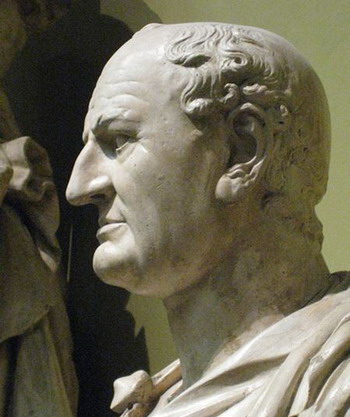
Titus Vespasianus Flavius, aka Tash Bash, aka Abraham
| 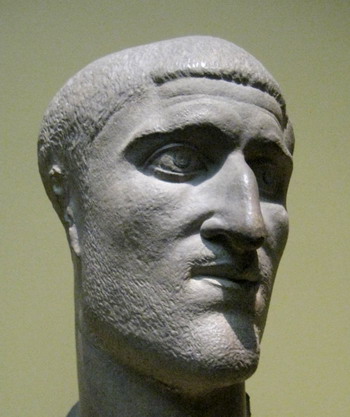
Constantius Chlorus, aka Aga Ruzha, it Isaac
| In the Bulgarian Chronicles said that Tash Bash at the end of life became intolerable for people – he gave different advices who and how should trade, interfered in all religious and economic affairs. According to our reconstruction [5], Tash Bash with his late son Aga Ruja in 150 in Arabia built the first Christian Church – the Cube/Kub/Qub or Kaaba. They worshipped the Cube as God Father and the God of the Sun. As a result Aga Ruja (Red Aga, 126–306), identified by us with Constantius Chlorus and Isaac, challenged his father to a duel on the Rock of Cube/Qubbat as-Sakhrah or the future Temple Mount at 37 years old (according to the Septuagint and our hypothesis) in 163. In the battle son defeated the father [8], whose hand was taken by an angel. This episode was embellished and appeared on the pages of the Bible as story with the sacrifice of Abraham's son Isaac to God. Bulgarian Chronicles report that Tash Bash lived more than 150 years (156 years).
According to our reconstruction of history [5], Emperor Constantius Chlorus (Flavius Valerius Constantius) was the last long-lived in the family of Ugric Kings. In the Chronicles of the Danube Bulgarians he was called Avitahol – the legendary forefather of the Bulgarian Kings, who lived in three centuries. In the annals of the Volga Bulgarians it is called Agar-Jay or Aga Ruja (Red Aga), the first Urus/Rus (Great) and the first ruler of the Khon (Huns) dynasty Dulo, volume III, p. 90 [8]. Emperor Constantius Chlorus (yellow-green) and Khagan Aga Ruja were bright red people and lived at same time, which confirms our identification. The date of death of Constantius is known (306), and according to the Bible he lived 180 years, so the date of birth is 126. If you subtract the date of birth of his father is 9, it turns out that Abraham gave birth Isaac in 117 years old, and did not in 100 years old.
| 
First Christian Church - Kaaba
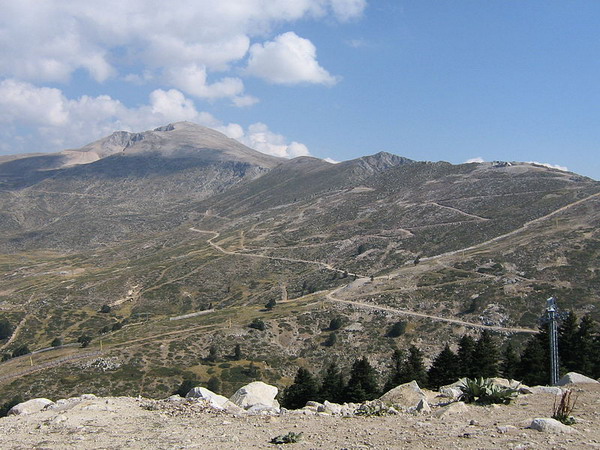
True Bithynian(small) Olympus, Uludag, 35 km from Prusa (Bursa)
| Thus Constantius Chlorus – Aga Ruja – Isaac was born about 126 and died in the British campaign in the 306. The Patriarch managed to live in three centuries of the Era of Christianity. His wife was Boyar-Kyz, given birth son Barys/Kubar Tucci. In the first half of the third century Constantius became King of the Prusa city and was named Prusias I of Bithynia. We believe that the traditional Dating of the reign of Prusias in 230–182 BC is erroneous, since in reality it is 224–272. The name of city the Prusa literally means the Throne of Russ or the Throne of the Great. Since then the Prusa remained the property of the Russ–Flavians until the time of Rurik. In 35 km from Prusa is the Mount Bithynian Olympus, where we believe lived the Olympic pantheon gods of Ancient Greece. Therefore, the Throne of Russ was at the foot of the Mount Olympus.
It is no accident Constantius Chlorus met his civil wife Elena (concubine) in an Inn of the suburbs of Prusa. Soon Elena (230/250–330) gave birth to her first child – the future Emperor Constantine the Great Flavius, who became the second King of Prusa – Prusias II. Incorrect traditional Dating says that Prusias II of the rules in 182–149 BC, and in fact, in 272–305. Elena and Constantine were recognized Equal-to-the-Apostles Saints of Christianity. So, from the III century the Prusa city was the ancestral throne of Russ, and the province of Bithynia – the ancestral home of the Vikings and the Varangians. In 1923 the Ataturk government renamed the Prusa city to Bursa, removing inconvenient historical name from the world map.
Further adherence to Biblical chronology in our era, taking into account the discovered chronological shift for the period of life of Abraham in the size of 1821 years according to Jewish tradition and 2183 years according to the Septuagint, leads to significant errors and does not correspond to historical facts. Note that we have found chronological shift 1780 years in the chronology of Ancient Egypt [5, 6], which roughly coincides with the Jewish tradition. At the same time, we understand that idea of the domination of Jewish chronology is a priori erroneous, since Judaism according to our reconstruction and logic of events, arose later than Christianity and in fact radical branch of Christianity, and not an older religion.
Constantine the Great (250/272–337) is identified by us with the Ugric King Kubar/Barys of the Bulgarian gens Dulo. Constantine was born from concubine and was recognized as illegitimate. The followers of Constantine in the Bulgarian Chronicles were called Kubanits or Kubarci [8]. We believe that Constantine became the prototype of St. George, as he was Tetrarch until 312 and lived in Anatolia. According to our reconstruction [5], Constantine defeated Maxentius troops at the confluence of the Laba and Kuban rivers in the North Caucasus (Krasnodar region). Hence the name of the symbol is Labarum (Laba – stick). Constantine proclaimed Christianity the state religion of Rome and held the First Council of Nicaea in 325. He moved the capital of Rome to the Golden Horn and the Bosporus from Akhtuba in 324–330.
Jacob, Israel, Ya’qub, Nabit (Arab.) is Patriarch of the Abrahamic religions. Jews and Christians interpreted the name Jacob as derived from the word "heel, trace", although the Arabs simply called it Cube. In fact, Jacob is derived from the name of God Father is Cube/Kub/Qub. For the struggle with God in the river (the battle on Laba river with Maxentius), he received the second name Israel. He revealed to the world the 12 tribes of Israel, he is father of Judah. We identify Jacob – Israel with Constantine the Great – Kubar. The followers of Constantine–Kubar–Israel were called the Israelites or Kubanites in the non-canonical Scripture of the Danube Bulgarians [12] of the Exodus of Moses: “…Kubanites (Bulgarians)... the 600,000 men on foot, besides children” (Original: “…кубаните (българите)… 600 000 пешаци мъже, освен децата”)
| 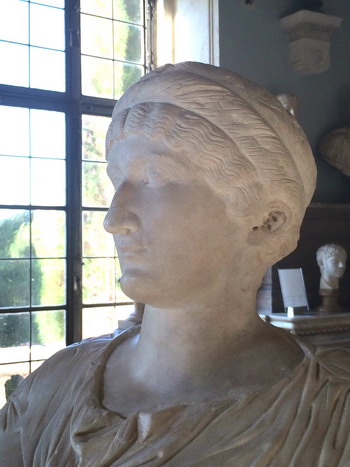
Equal-to-the Apostles Saint Helen
| 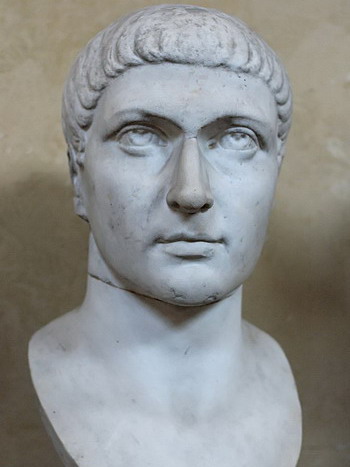
Equal-to-the Apostles Saint Constantine the Great
| Balamber, Bulumar-Sheke, Budimir (board 363–378) are became the first King of II Hon dynasty [5], III volume, page 89. Initiated and conducted a major military reform of the troops of the Kubanites – Bulgarians. Vanguard army was called Urus (Great) Saban. Balamber moved the capital of Idel from the Volga region to Kara-Saklan (Ukraine) to the rate of Kan-Balyn (future Bashtu, Kiev) founded by him. The Kievan hill where it was buried, got his nickname Sheke (Schekovitsa on the Ruthenians language).
Valens II (Flavius Julius Valens) is the Roman Emperor, life (328–378), board (364–378). Fatherhood is attributed to Gratian the Elder. According to our reconstruction of history [5], Valens is the son or nephew of Emperor Constantine the Great. He was killed in battle with armies of barbarians – the Huns under the leadership of Balamber at 9 August, 378. The death of Emperor is not confirmed, as the body was not found. In one battle historians have reduced as opponents two hypostases of one historical person – Romans and barbarian. In the future, we will find few more such tricks. We believe that in fact in 378 there was battle between the Huns (Commanders Balamber and Arbat) and the Visigoths (Commander Fritigern). In the battle was killed Khagan Balamber, called in the history Emperor Valens. Recall that the Huns are Eastern Romans from Rome on Akhtuba [7].
Judas is the fourth son of Patriarch Jacob. In the tree of the Prophet Muhammad is called Yashjub. We identify Balamber/Budimir – Valens II – Judah – Yashjub as one historical person who lived in the IV century.
Arbat, Alyp-Biy, Svyatogor (Khagan 378–402), volume III, p. 90 [5] is the eldest son of Balamber and Turan-Bika, continued the Idel dynasty of Iji (Pharaoh Iti and King Ascanius) and I–II Hon dynasty Dulo. He was born in 361and rules Idel 24 years. He destroyed the Visigoth army that attacked Constantinople. He organized the first wave of Exodus – the Migration period of peoples from the Volga region and the Caucasus to Eastern and Western Europe in the 380th.
Theodosius I the Great Flavius (Flavius Theodosius Magnus) the last Emperor of the Roman Empire, life (346–395), board (379–395). Thus Socrates Scholasticus [13] reported that Theodosius the Great lived 60 years, therefore he died in 405. On January 19, 379, he was declared Dux Moesiae (Leader Moses) and Emperor of the Eastern Roman Empire. Theodosius Flavius first time came to Constantinople in 380, where he issued the edict De fide catholica, as the only state religion of the Roman Empire. In 381 he held the First Ecumenical Council in Constantinople. In 390 at the Hippodrome the obelisk of Thutmose III was erected, brought to the embankment of Constantinople by the Egyptians in 355 [6]. On the basis of the obelisk was placed the marble bas-reliefs depicting the struggle of the chariots, the scheme of installation of the obelisk and portraits of Theodosius with the family and the environment. After that, the Emperor banned the Olympic Games and allowed only chariot races, symbolizing the chase and getting rid of the pursuers. On the Racetrack was also installed copper Snake Column composed of three bodies of writhing snakes. The Obelisk and the Snake Column have survived to the present day. In 391–395 he adopted an edict banning paganism.
Moses is Jewish Prophet and legislator, the founder of Judaism, led the Exodus of the Jews from Egypt. He lived 120 years supposedly in the XIII century BC. In Hebrew Moshe means "taken from the water." Moshe is Musa at the Arabs, Moses – in English. Nickname is Leader Moses. Moses gave the Egyptians 10 plagues, led the Israelites out of Egypt across the Black (Red) Sea. He received the Ten Commandments from God on Mount Sinai, near which they found the salt lake of Merah. He used the brazen serpent to fight the reptiles.
| 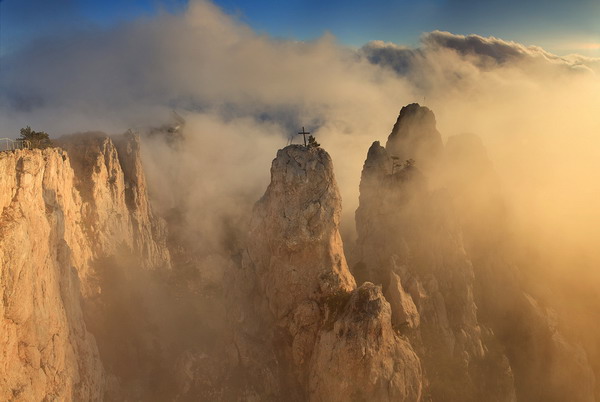
Crimea, aka true Sinai, the Mountain AI-Petri
|
We identify Arbat – Theodosius the Great – Moses as one historical character, in detail pp. 451–457 [5]. His life time is 345–402, the board 378–402. In 378 Arbat led the first overpopulation of the Israelis – Kubanites, residents of the Volga the Ulak Urum city (Ancient Rome) in the amount of 600 thousand people. January 19, 379 Ugric King Arbat transferred refugees on the ice of the frozen Black Sea in the area of Tuzla Spit from the Kuban to the Crimea is the original Sinai. The Romans pursued the troops of Pharaoh Thutmose III, who settled in Rome – Memphis on the Volga since 324 [6]. The weakened ice from the carts of refugees, named after Arbat is arba/araba, fell under the wheels of the Pharaoh's army chariots. Most of the pursuers drowned in the Black Sea. Roman refugees came to Sinai, where Arbat on the Mountain Rock of Ai–Petri has received Tablets of Stone the Covenant with God. For many months the refugees tried to find a way out of the Crimea to the mainland, but ran into the salt lake Sivash (Lake of Merah). Soon passage was found. This braid is still called in honor of the King of Arbat – Arabat Spit. One of the cities of Crimea was named in honor of the Emperor Theodosius the Great – the Feodosia town.
Kubanits–Bulgarians–Israelis–Romans, now called the historians the Huns and Goths, were transported to the Balkans and got to Europe. The word Moses became a household word, and people began to use it as term for the name of the Prophet. The name of the province of Moses (Moesia) became synonymous with Salvation, the Promised Land. So, Savior called since Messiah. In Orthodoxy not say Moses, but Leader Moesiae, that confirms our reasoning.
| 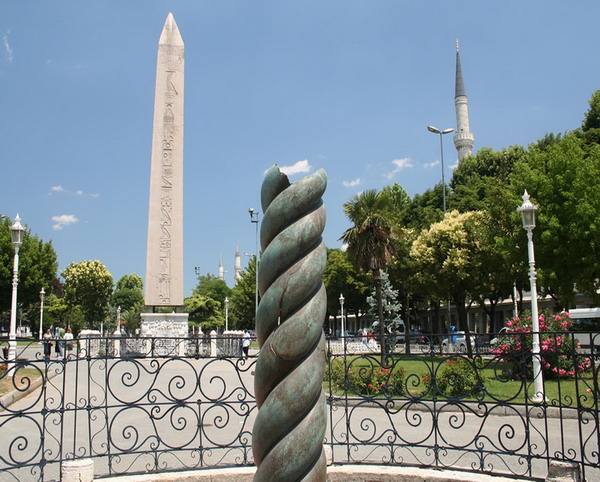
Hippodrome on Constantinople, Serpent Column and the Obelisk of Thutmose IV
| Attila, Aetcel is the Ugric King in 434–453, volume III, p. 91 [8]. He is the son of Mundzuk, the most famous Bulgarian King and conqueror. He was born in 401, was co-ruler in 434–445, and then sole board Idel. In his reign, the Power became the largest Empire in the history of mankind from China to France. After the death of Attila in the reign of son Tengiz, Idel was divided into Kara-Bershad (Danube and Dnieper area), Ak-Bershad or Echke Idel, Internal Idel (Volga-Ural part of Idel) and Eskel (Siberian part of Idel). European chroniclers called it the scourge of God. Attila led the second wave of Exodus or Migration period in the 440–450th.
Flavius Aetius is the commander of the Western Roman Empire, was awarded by historians the epithet the Last of the Romans. He was killed in 453 or 454. He is considered a participant in the battle on Cataluanian Plains and the winner of Attila. The name Aetius is identical to one of the names of Attila – Aetcel.
Theodosius II Flavius (Flavius Theodosius) are Emperor of the Eastern Roman Empire for 48 years. With 402 was minor co-ruler father Arcadius, and with 414 in fact rules his sister Pulcheria as Regent and Augustus. Then his wife Eudocia and the eunuch Chrysaphius ruled. It is believed that Theodosius II did not deal with the affairs of Empire, and Board trusted his relatives and courtiers. In fact Emperor had never been in Constantinople. Theodosius II died in an accident in 450.
Joshua is the Biblical Patriarch, Moses ' successor. He is the leader of the Jewish people during the conquest of Canaan. He conquered the Promised Land (Land of Israel) for the Israelites. He showed unprecedented cruelty to his enemies. After the conquest and division of the earth Joshua peacefully died on mount Ephraim.
We identify Attila – Flavius Aetius – Theodosius II – Joshua as one historical person, who lived in the V century. The Promised Land for the Israelites – Kubanites is Europe and the Balkans, which were captured by the troops of the Huns – Romans from the Volga region and the North Caucasus.
Let’s forward to the reign of Kings Saul and David.
By adulthood Kurbat the state rule from his name make Yurgan (Burgan) Teles (602–605), volume III, p. 95 [8], who was uncle (brother of the Alburi wife) of Kubrat. Before the Board as Khagan, Jurgan served as chief judge (ijik). Yurgan had to rebuild state disintegrated after death of Alburi on 60 Principalities (tub).
Usurper Emperor Phocas (Flavius Phocas Augustus), life 547–610, rule 602–610, assassinated or committed suicide in 610. Phocas was elected Emperor by the rebellious troops. The reign of Phocas was marked by a series of extrajudicial killings and cruel executions.
King Saul is Biblical character, the founder of the United Kingdom of Israel. The Jews believe that the name Saul means Borrowed from God. In the Quran, Saul is called Talut. According to one version, Saul was military commander, proclaimed King in Gilgal after defeating the Ammonites. According to one legend, Saul is one of the Judges. The character of the King was a complex and explosive. At the end of his life in one of the battles Saul was wounded and committed suicide.
We identify Yurgan–Focas–King Saul–Talut of as one historical person living in VI–VII centuries. The ruler was originally a judge of the Bulgarians – Israelites, who later became the King – Emperor. He did not belong to the family of Ugric Kings, so his rule was illegal from the point of view of the gens Flavian–Dulo–Russ. The history of Saul and Focas is confirmed by the Chronicles of Bulgarians, which are the basis of the Annals of the Byzantine Empire and the Scriptures of the Old Testament.
| 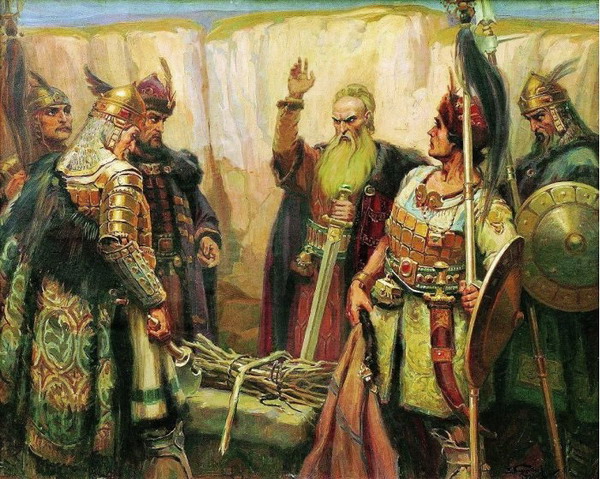
Great Khagan Kubrat, aka Emperor Heraclius I, and sons
| Great Khagan Kubrat, Kurbat, Kurt or Khor are live 593–660, board 618–660 [8]. He is the eldest son of Khagan Alburi, volume III, pp. 95-96 [8]. Ugric King Kubrat was born directly in the Porphyry Chamber of the Great Palace of New Rome, where only Emperors were born. Until 12 years old he lived in the Imperial Palace, was baptized and received the title of Caesar. The Empire of Kubrat – Great Bulgaria or Great Israel – stretched from the Yenisei to Central Europe, volume II, page 16 [5]. In 629 Turkic Khaganate broke into two parts – Balasagun (Central Asian and Mongolian) and Khazar (Western Kazakhstan) then Kurbat immediately subdued Suar beylik and in the 630 proclaimed the re-United parts of Idel the United Bulgarian Kingdom (Bulgar, Bulgaria). From now on, the territory of the Volga region forever received its historical name – Bulgar (Bulgaria), and the name of Idel was assigned to the Volga-Kama rivers system and to the names of the seven largest rivers of this system styles add the word Idel. The state of the Bulgarians was also called Kara-Bulgar that is Great Bulgaria. The capital of the state was Phanagoria – the city of the former Bosporan Kingdom.
Kubrat had five sons is Bat Bayan (Ilat-bir), Kotrag, Asparuh, Kuber and Alcek. Bat Bayan inherited the throne of Great Bulgaria. Kotrag headed the Volga Bulgaria. Asparuh became the Khan of the Danube Bulgaria. Alcek and his Horde moved to Central Europe and stayed in Northern Italy.
Heraclius I (Flavius Heraclius Augustus) is Byzantine Emperor, founder ruled more than 100 years of the dynasty of Heraclius (life 575–641, board 610 – 641). The young Emperor came to the throne of Rome by overthrowing the tyrant Phocas in 610. It is claimed that Heraclius I was a close friend of Kubrat, with whom he studied together. This situation is surprising, because according to the traditional chronology Heraclius I must be older than Kubrat on 20 years. The alleged children's friendship of the leaders led to the conclusion of a peace Treaty between Great Bulgaria and New Rome.
At this time the main enemy of New Rome was the Persians, who seized Syria in 611 and 614 the Palestinian Al Quds (Jerusalem). 35 thousand inhabitants of the city were captured [14] and were sent to Seleucia – Ctesiphon (Babylon). The Emperor spent a lot of time in military campaigns in Asia Minor, Palestine, Egypt and Arabia, until 628. During this period, a new Muslim calendar – Hegira appeared from July 16, 622. After the liberation of Palestine from the Persians, Heraclius I ordered to restore the Church, built by his ancestors in the 330th – Equal-to-the-Apostles Saints Constantine and Helena on the Temple Mount.
King David is the second King of Israel the name translates as "beloved". Reigned 40 years in the X century BC. He created Great Israel in the outlines of the Promised Land. He began construction of the Temple, which was completed by his son Solomon. In the ancestral tree of the Prophet Muhammad he is called Mudar. In the Chora Church in Constantinople (XIV century) on the dome of the temple David is called Dad, i.e. Father.
| 
Great Bulgaria - Great Israel, VII century
| Kubrat–Heraclius–David–Mudar this is one historical person living in VI–VII centuries. Great Bulgaria and Great Israel is one state created by Kubanites–Bulgarians in Europe and Asia Minor. Part of Israel belonged to the territory of Palestine, which included the city of Al Quds and Syrian Damascus. Soon, the shard of Great Bulgaria – the Umayyad Empire became an independent power. We believe that Kubrat – Heraclius I became the prototype of personality of Prophet Muhammad (570–632), although the Prophet himself lived in the XI–XII centuries.
The emergence and formation of Judaism associated with the Babylonian captivity in 614–628 during the Byzantine–Sasanian War. In the first third of VII century the Babylonian Talmud was written. The Jewish tradition states that the writing process took about 600 years, starting from the middle of I century. However, there is no Jesus Christ in the Talmud, because he has not yet been born.
At the same time, the religious war of Heraclius I – Kubrat on the formation of huge Great Israel affected Arabia, where Islam arose, and new Muslim chronology of the Hegira began in 622. Already in 637 the Arabs finally defeated the Sassanid Empire. In 661 the Israelis of Great Bulgaria – Great Israel, relatives of Kubrat–Heraclius I, conquered the Levant and founded the Umayyad Caliphate there.
The Great Khagan Sulabi is the son of Bat Bayan, volume I, p. 23 [8]. Another name of bat Bayan was Ilat, which coincides with the Arabic name Ilyas in the genealogy of the Prophet Muhammad. Ilyat was born in 617. In 643 he converted to Islam, made the Hajj and visited the Caliph Omar, whose name took for him.
Sulabi headed to Kara–Bulgar, and let everyone know about the permission of Tengri on his 45-year reign. Sulabi unlike his father disliked wars and tried to avoid them. Sulabi willing to trade and made lively land and water routes, reaching in Avar, Artan, Rum (Rome), Galdo, Seber and Kashek, volume I, p. 23 [8].
Flavius Justinian II Rhinotmetus is Byzantine Emperor, the last representative of the dynasty of Heraclius, life 669–711, board 685–695 and 705–711. He held the Ecumenical Council in Trullo in 691–692. Nicknamed Rhinotmetus for physical deformity in 695 insurgent commander Leontios cut off the Emperor's nose and tongue. After that Justinian fled to Phanagoria, then to the Khazar and then to the Volga Bulgaria, where he hid for seven years. In 705 he arrive the Constantinople with the Bulgarian army of Khan Tervel and regained power. He fought with Arabs in Asia Minor. Usurper of Philippikos Bardanes captured Emperor Justinian December 11, 711 and killed, beheaded. Justinian's daughter Anastasia was married to Khan Tervel, her cousin.
Sulayman Ibn Abd al-Malik (674–717) is the Umayyad Caliph in 715–717.
Solomon is the third Jewish King, ruler of Great Israel in the X century BC. The name means "peace". There are other names attributed to King Agur, Bin, Itiel and Jedidiah (beloved of God). He is the son of King David and Bathsheba. During the reign of Solomon the temple of Jerusalem was built on the Temple Mount. No historical evidence of Solomon's existence has been found. Died peacefully at age 62, while watching the construction of the altar of the Temple in Jerusalem.
We believe Sulabi–Justinian II Rhinotmetus–Solomon–Mudrik (Amir)–Sulayman Ibn Abd al-Malik is one historical person who lived in VII–VIII centuries. During the reign of Sulabi–Justinian II in 711 was completed the construction of Temple of Jerusalem on the Temple Mount, which stands in its place until now.
Construction of the Temple was started in 616–626 by the grandfather of Sulabi–Justinian II named Kubrat–Heraclius I. The temple is made in the form of an octagonal star of Russ, formed by projections of two bases of regular pyramids on the plane. It is called Qubbat as-Sakhrah or the Rock of Cube, which confirms the presence of the name of God Father are Cube/Kub/Qub. In honor of Kubrat named shrines and buildings in Arabia and Damascus (Treasury of Kubrat/Qubbat al-Khazna and Fountain of Kubrat).
According to our reconstruction of history [5], Sulabi – Justinian in the years of forced emigration visited Siberia and Yakutia, where he discovered diamonds and developed the mines of King Solomon. Having saved enough money, he hired an army of Bulgarians regained the throne of the Empire in Constantinople in 705.
| 
Temple of Solomon, aka Qubbat as-Sakhrah
| After Kubrat – Heraclius I and Sulabi – Justinian we restored the direct family tree of Ugric Kings and Emperors of New Rome up to Rurik and St. Vladimir [5, 11]. It is important to note that this line exactly coincides with a similar section of the ancestral tree of the Prophet Muhammad [14]. We are talking about the Patriarchs of Islam and Ugrian Kings: Mudar (Kubrat, Heraclius, David), Ilyas (Ilyat – Bat Bayan, Constantine IV), Mudrikah (Sulabi, Justinian II, Solomon), Khuzaimah (Ayar, Leo III), Kinanah (Karadjar, Constantine VI Blinded), An-Nadr, Quraysh (Aydar, Leo), Malik (Rurik, Lachin/Lekapenos), Fihr (Igor, Roman I Lekapenos), Ghalib (Gleb, Constantine Lekapenos) and Luay (Vladimir, Basil II).
Urus Ugyr Aydar (Russ Igor Aydar) is the founder of gens Russ and gens Quraish.
Let us turn to the circumstances of the birth of the Virgin Mary and Jesus Christ, which occurred in the X century. Mary's parents were the Holy Prince Vladimir and Empress Anna Macedonian (Bizantine). The spiritual father of the Virgin was Joachim Bishop of Chersonesus (Korsun), and then Novgorod the Great, and close friend of Anna Macedonian. Anna devoted her whole life to the education of Mary, who was appointed to realize the dream of Christianity about immaculate birth of the Savior. Mary from childhood chose to serve God as the goal of her life. For these reasons, Prince Vladimir lost interest in the Byzantine wife, hitting the fornication. He married many times and started a huge harem, which contained several hundred women.
Vladimir (Volodimer), in baptism Basil is the Prince of Novgorod in 970–988, the Grand Prince of Kiev in 978–1015, life about 960–1015. Date of birth is not exactly known. In PVL [15] in the text of the peace Treaty with Byzantium for 945 Vladimir is mentioned as the participant of the transaction. For him the signing was attended by father Gleb (Uleb).
After the wedding in 960 Anna gave birth to her only daughter Maria (961/962–1060), information about her life is completely absent in the Chronicles [11]. Since 988, Vladimir's troops became part of the Byzantine guard. In the capital is located Varangian corps numbering 6,000 people. Since then, the Vikings participated in all the wars of the Empire, for example crushed the revolt of Bardanes Phocas. In 1014 Russian troops participated in the war against the Danube Bulgaria, defeated the enemy and captured 15,000 Bulgarians. It is believed that Grand Prince Basil died July 15, 1015 buried in the Kiev Tithe Church. The relics are lost or hidden.
Bulymer is the son or stepson of Barys (Svyatoslav) and Malusha, daughter of Mal. Active acts Bulymer began immediately after the beginning of the reign in Kiev in 981, volume I, pp. 102–104 [8]. Have describes the military campaigns Bulymer against different opponents. In 981 a campaign against Volga Bulgarians which ended with the accession to Russ the Vyatichi tribes. In 988 the Bulymer invaded Galdo (Crimea) and seized Rumsky city (Chersonesus). As reward he got lot of gold and silver, and Dima–Tarhan in the bargain (we are talking about a woman). In 991 Bulymer troops with the Romans attacked the Khin town. After the Bulymer death was the war between his children for throne of Russ. According to the source, the last report of this war dates back to 1021, volume I, p. 108 [8].
Kubar (Khin Kubar) is son of Ghalib (Gleb). In the description of the life of Muhammad Khan (943–976), son of Michael and grandson of Almush, there are characters Ghalib and Kubar, volume I, pp. 85–90 [8]. After 944 the name Ghalib is not mentioned. But Kubar became Bek (Prince) of the Khazar capital Itil. In 966 or 969 Kubar passed without a fight Itil to Barys (Svyatoslav), his uncle.
It is believed that Kubar disappeared from the annals of Khazar in 969, but appeared in the person Vladimir in the Principality of Novgorod. At the same time, the Bulgarian Chronicles note that several Princes of Russ were named after Kubar or Khin Kubar. The first such ruler was Polymer (Vladimir), volume I, pp. 165–166 [8]. Khin Kubar was also called the son of Yaroslav the Wise Vladimir and Vladimir Monomachos. St. Vladimir was popularly nicknamed the Red Sun, which is the literal translation of the "pagan" name Khin Kubar.
Basil II Bulgar Slayer is the Byzantine Emperor of the Macedonian dynasty, son of Emperor Romanus II and tsarinas Theophano, the successor to the throne of John I Tzimiskes. His years of life are 958–1025, the reign 976–1025, in fact, began to reign only in 985 after the ouster of the eunuch Basil Lekapenos. No details about the personal life of the Emperor and his family are known. It is believed that Emperor Basil II left no offspring. Instead of family life Basil was fond of military fights. All his life he spent in battles and conquests, for victories on the Danube Bulgaria was nicknamed the Bulgar Slayer. The basis of Basil's army was the Varangian squads sent to Constantinople by the Grand Prince Vladimir – Basil. Each Varangian had family, so in Constantinople after 988 housed huge Diaspora of Russian – more than 30,000 people. Historians say that Basil II led an ascetic life, taking care of his army more than about his well-being.
Luay is ancestor of Prophet Muhammad, the son of Ghalib and is father of Kaab.
We identify Vladimir–Basil–Bulymer–Kubar–Basil II–Luay–Kaab as the one historical person living in X–XI centuries [5, 11]. Father of Vladimir was Gleb – Ghalib – Emperor Constantine Lakapenos, the younger brother of Svyatoslav – Barys –Emperor Stephen. Mother was Malusha – Theophano Mamas, daughter of Mal – Caesar Roman Lakapenos and granddaughter of Almush – Emperor Christopher Lakapenos.
In 981 Vladimir seized power in Kiev and received the title of Grand Prince of Kiev. In the period 987–989 Vladimir was baptized under the name Basil. With 976 was the formal co–Emperor of the Byzantine Empire jointly with his cousin Constantine VII, but in fact ruled the Empire, the eunuch Basil Lakapenos. In 985 Basil II expelled the enemy from power and became a full Emperor. Basil has reorganized armies of Byzantium, introduced a walking case of the Vikings and the Navy on the basis of a boat of Vikings. Russian troops participated in all military operations of the Empire in the 985–1020. St. Vladimir was the father of the Virgin Mary and grandfather of Jesus Christ Zlatoust (Chrysostom), witnessed the Biblical events of the New Testament. Vladimir died in the period of 1015–1021.
In the family tree of the Prophet Muhammad after Luay – Vladimir should Kaab that is Cube/Kub or God. According to our hypothesis Kaab means Bulgar name Kubar, "pagan" or Muslim name of Vladimir. Therefore, an extra knee appeared in the Prophet's tree, which is mistake.
| 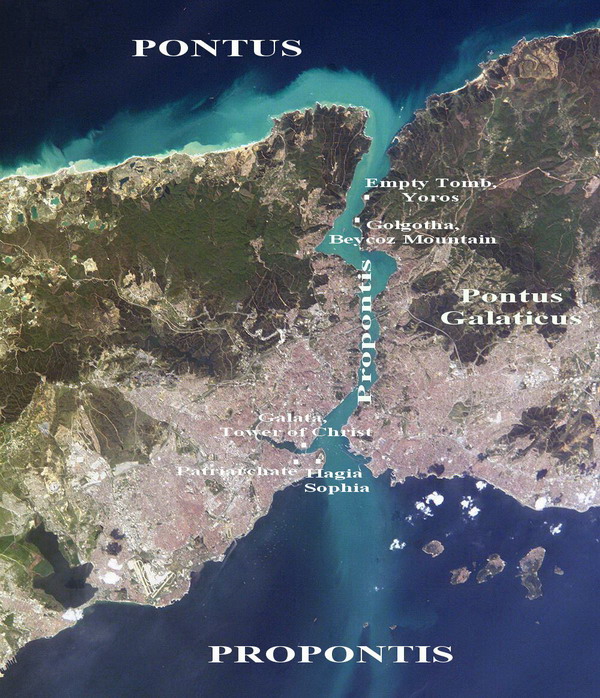
Figure No. 1. Holy places of the New Testament in Constantinople
| The Virgin Mary is daughter of Prince Vladimir and Princess Anne Macedonian. In the family tree of the Prophet Muhammad is listed under the name Murra. Date of birth 961/962. Date of death is after 1060, she lived more than 100 years. Her spiritual mentor and father Bishop Joachim, Bishop of Chersonesus and Novgorod the Great. In the Gospels Mary's parents were Anna and Joachim. In Novgorod in the XI century was built the Church of Joachim and Anna. The whole family of the Virgin Mary was from the Macedonian dynasty and Lakapenos. She devoted her life to the service of God. In beginning of 979 visited relatives Elizabeth and Zechariah in the fortress of Yam Golden Cup. Elizabeth became immaculately pregnant in the absence of her husband. Mary/Maria Vladimirovna used water from the Holy spring of the Golden Cup, immaculately pregnant and gave birth to the son of Jesus Zlatoust/Chrysostom in 979/980 (at the junction of years). As a bequeathed gift from his grandmother Malusha received village Buditino [16].
Together with her son hid from the wrath of his father Vladimir in Itil, on the Volga (Lower Egypt). During the Biblical events she accompanied her son on journey through Damascus, Al Quds (modern Jerusalem), along the coast of modern Turkey and Greece; she was with her son on Mount Athos, and at the end point of the route – in Constantinople, the true Jerusalem. In the capital lived in Blachernae Palace, owned by her mother Anna. Mary was one of the richest and most respected women of her time. After the crucifixion and resurrection of Jesus she moved to residence in Ephesus. In 1024 the rite of ascension of the Virgin in Constantinople from where the Virgin moved to Dalmatia, the city of Loreto took place. From time to time she visited Constantinople, participated in the settlement of the conflict between Russ and Byzantium in 1043. As a result, the Emperor was her brother Yaroslav the Wise, aka Constantine Monomachos, and the wedding of Vsevolod and Princess Irina. The Patericon of the Kiev Pechersk Lavra [17] is describes in detail the meetings of the Virgin Mary in the 1050th with the architects, builders of the Dormition Cathedral in Kiev. The Virgin paid for the work and presented the builders with the relics of saints, and as well as her icon for the Cathedral. Ten years later she again visited Constantinople and hired icon painters to paint Church in Kiev, as well as to train Russian artists. The late commentators of the Patericon explain events as miracle, therefore characterize the Virgin and her numerous servants as "ethereal angels".
The Virgin died after 1060, having survived her Son Jesus Christ (980–1054). It was put in marble Italian sarcophagus and transported to Kiev, where it was buried near the limit of John Baptist in the Dormition Cathedral. In 1617 the sarcophagus with the body of the Virgin was found. Currently, the relics of Virgin Mary under the name of Julian are stored in the Nearby Caves of the Kiev Pechersk Lavra.
Jesus Christ Zlatoust/Chrysostom are Lord Savior, God the Son, the triune part of the Christian Trinity. Theoretically it was predicted and described by the ancestor of male line of Tash Bash – Titus Vespasian Flavius – Abraham in the I century, named by Romans in his honor the Era of Christianity [5]. The First Millennium was time of Old Testament Christianity, when believers in the Savior waited hundreds of years for his arrival. The main temple of that period was the Hagia Sophia – Wisdom. The Second Millennium is time of New Testament Christianity.
In the earthly life Jesus Christ Chrysostom was born at the junction of 979/980 [5]. The place of birth is not yet exactly established, according to our hypothesis it is the Yam Kubar on the river Kubra (Vladimir region, Russia), which is a couple of kilometers from the place of the immaculate conception of Mary in the Yam the Golden Cup. An alternative place of birth is the Prusa city (since 1923 is Bursa) in Bithynia, the throne of Russ and Rurik in Byzantium.
The Lord has accomplished his feat in the name of salvation of mankind from sin in the capital world of that time – Constantinople (New Rome) on Golgotha in Galatia (Mount the Adam's Head/Bed of Hercules, Mount the Beykoz it is the Asian part of Istanbul) on March 18, 1010. The Savior was put in Tomb in place called Yoros, the true Jerusalem of Christianity. The caves of the cemetery were located a couple of kilometers from Golgotha, closer to the Black Sea on the shore of the Bosporus. In 1055 the construction of huge city Yoros (Jerusalem) began there. Around the Empty Tomb of the Lord and the Temple of Victory (Nike) of Jesus Christ was built a fortress that has survived to our time. The main point of difference with the canons – Pontius Pilate is not a man, but a place – Propontis Galata (Figure No. 1). Note that Jesus Christ was crucified on the cross not by Jews, but by zealous Christians who thought that he was a false Messiah.
| 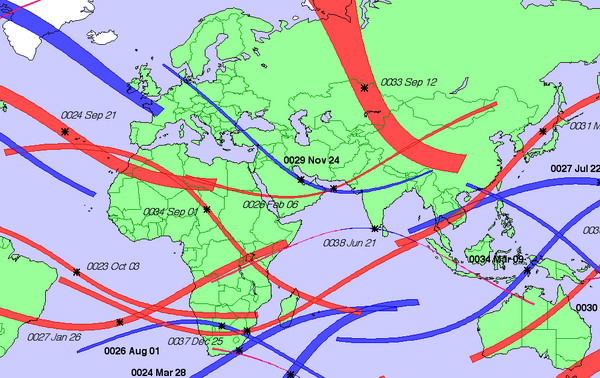
The Solar Eclipse period of 20 - 40

The Solar Eclipse period of 1000 - 1020
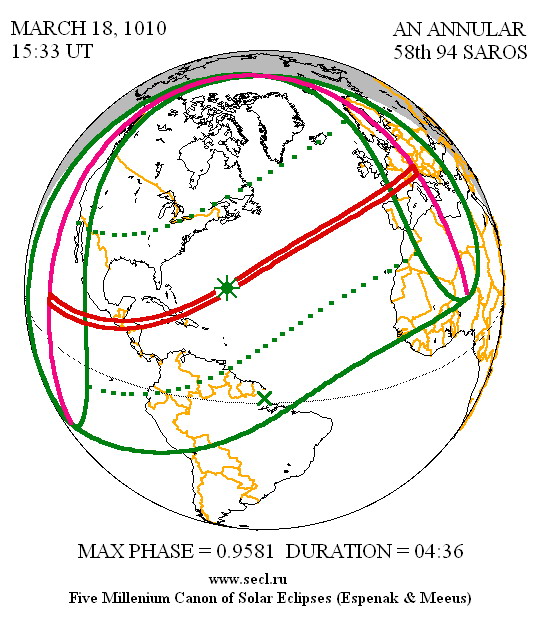
Figure No. 2.The Solar Eclipse of 18.03.1010, 94 Saros

Annular Solar Eclipse at sunset.
|
Luke (23:44), Mark (15:33), and Matthew (27:45) say that at the time of the Savior's death on the cross, there was darkness from the sixth hour to the ninth (from 12–15 to 15–18 o’clock). In the beginning of our era in the Mediterranean was not a single solar Eclipse that fits this description – at the end of the day. Only March 18, 1010 was such a circular Eclipse [18, 19], lasting 4 minutes 36 seconds at 15:33 UT or 18:33 Constantinople time in 94-Saros (Figure No. 2, [19]).
The Eclipse was well observed in Europe up to the Balkans, and the penumbra of the moon stayed in the region of Constantinople and Anatolia for several hours. This type of Eclipse along the latitude is characterized by maximum duration and darkening at the final part of the event. The phenomenon occurred in the evening hours, which increased the feeling of the coming night. On this day the sunset in Constantinople was at 18:12 o’clock, and astronomical twilight until 19:44 o’clock. Therefore, in the touch of the sun the line of the horizon start the Eclipse, visible on the Golgotha – Mountain Beykoz. Darkness came, which was multiplied by the shadow of the moon. Twilight or enlightenment occurred, which increased the severity of the perception of the Savior's death. This natural phenomenon is unique to the Mediterranean, so it was noted in the Gospels and is still not explained by theologians. Date of the Eclipse of March 18 do not fit into modern ideas of Paschal (before the equinox), however the Jewish Passover happened the week before 21 March and was recognized by the theologians inaccurate because of ignorance of the Jews. For 2,500 years were still two Eclipses with similar were-in 16.04.934 in 15:42 UT and 05.04.1437 in 16:46 UT. However, the Eclipse in 934 took place to North on 2,000 km in latitude and in 1437 was about latitude Eclipse in 934, but the shadow line of the moon not reached even to Greece.
After the resurrection and ascension, the Lord personally participated in the development of monasticism on Mount Athos, many times visited the mountain Monasteries. According to the Patericon [17] Jesus Christ gave before his crucifixion the Crown and gold belt to the Governor of Kiev Simeon African. The belt was a measure of length for the construction of the Dormition Cathedral in Kiev. The Crown was placed over the altar of the temple. The Savior was sent from Mount Athos to Kiev monk Antony with the purpose of establishing in Russia of the monastery. Anthony fulfilled the will of Jesus Christ. The monk Anthony met many times with the Virgin Mary in Constantinople. All these events are called by modern commentators "mythology", recognized to exalt the value of the Kiev Pechersk Lavra.
After the resurrection, the Lord went around the Earth several times, visited India, China, Japan, and moved to America, where he founded the civilizations of the Toltec and Incas. In Mesopotamia he became known as the incarnation of Zoroaster, in India as the incarnation of Buddha. In China, he was celebrated as Confucius XI century and the founder of neo-Confucianism. In America, Jesus Christ in the middle of the XI century became the embodiment of Quetzalcoatl, born in 980 according to extant Codes. The Lord died for the second time in life on earth in the July 1054. The last days of the Savior in our world were accompanied by the explosion of Supernova in the constellation Taurus. At the place of the explosion is formed a Crab nebula. Jesus Christ is buried under the name Confucius in the Qufu city, Shandong province. There is a majestic tomb of all times and peoples, which has reached our days. Recently, the Chinese authorities opened the grave of Confucius and found in it the body of a red-haired man of European appearance growth of more than 190 cm.
In the Muslim world is known Emir of Mecca Isa ibn Jafar (980–994). The name of the Emir is translated as Jesus the son of God (Divine source). We believe that the dates of the Board of the Emirs of Mecca are underestimated by 10–15 years. Perhaps in his youth Jesus Chrysostom (Kilab in Islam) was at one time recognized as the Emir of Mecca, lived in Arabia and found a son Qusai. We also identify the Emir of Mecca, Abu Hashim Muhammad Ibn Jafar (1069–1094), with the great-grandfather of the Prophet Muhammad, the founder of the Hashemite [5]. Perhaps the date of the reign of Hashim is shifted by 10–15 years. Curiously, the Tomb of Hashim is under the dome of the Said al-Hashim Mosque in the Al Daraj district of Gaza in Palestine. The Mosque and Tomb were built in the early XII century.
| 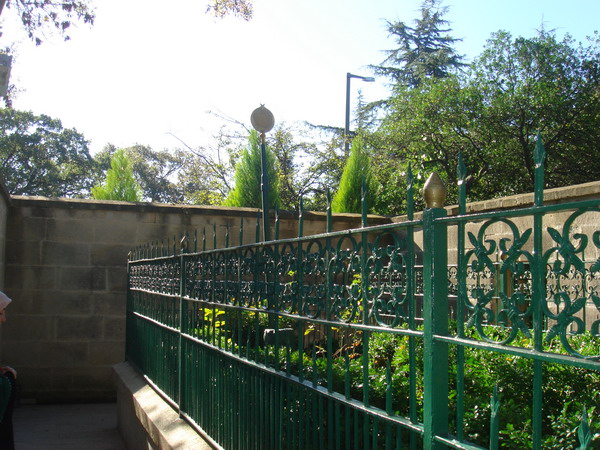
The place of Christ's crucifixion - Golgotha, the Mountain Beykoz (Joshua's Hill), the Tomb of Prophet Yusha

Yoros castle, ruins of the Church Nike of Jesus Christ, the Holy Sepulchre
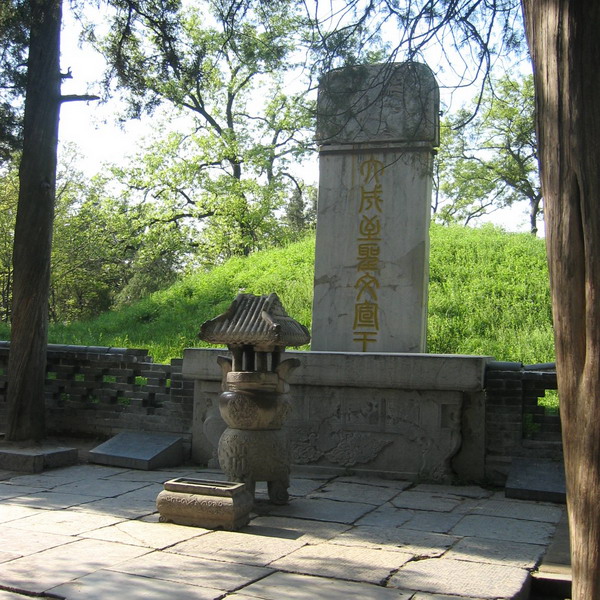
Memorial and Tomb of Confucius, aka Jesus Christ, the July 1054
| Yaroslav the Wise, is son of St. Vladimir and Polotsk Princess Rogneda, life 978–1054, Prince of Rostov (987–1010), Prince of Novgorod the Great (1010–1034) and Grand Prince of Kiev (1016–1018, 1019–1054). He was baptized as George. Historian Priselkov M. D. interpreted the translation of the title of Yaroslav the Wise as Emperor [20]. In the frescoes of St. Sophia Cathedral in Kiev the Yaroslav called Caesar, i.e. Emperor.
Ar–Aslap is Russian Bek, first mentioned in the chronicle for the 1021, volume I, p. 107 [8], and died in 1054. In the annals mentioned Monomachos, volume I, p. 108 [8]. The ruler of Volga Bulgaria Ibrahim sent to Ar–Aslap Khan's hat a copy of his hat. Only three such hats have produced a house of Master Atrak Bina of Musa. The third hat Ibrahim shortly before his death, sent with gifts to the Sultan of Khurasan Mahmud. In Russian history the Monomachos's cap was presented to Yaroslav the Wise's son Vsevolod.
Constantine IX Monomachos is Emperor of the Macedonian dynasty, rule (1042–1055), life (1000–1055), date of birth is not exactly known. He ascended the throne through marriage with Zoe Porphyrogenita, daughter of Emperor Constantine VIII. Often Monomachos historians erroneously recorded in ethnic Armenians, like all Lakapenos/Lecapenus and representatives of the Macedonian dynasty. His wife Zoe died in 1050, after which Constantine ruled together with her sister Theodora.
We identify Yaroslav the Wise – Ar–Aslap – Constantine IX Monomachos as one historical person who lived in the X–XI centuries. It is interesting to note the fact of full coincidence of years of life of Jesus Christ Zlatoust/Chrysostom (979/980–1054) and his uncle Yaroslav the Wise (978/979–1054), as well as the value of the personality of the Prince and Emperor in world politics. However, there is no reason to recognize them as one person.
Prophet Muhammad, the family of the Quraysh is a direct descendant of the Rurikovich. According to our hypothesis, the personality of the Prophet was formed by integration of the acts of two outstanding people of Earth civilization is the Great Khagan Kubrat – Emperor Heraclius, who lived in 575–660, and Muhammad himself, who lived in 1090–1152 [5]. Probably, the life of the Prophet Muhammad was somewhat closer to our time in 1100–1162 (10 years later). The main achievement of the Prophet Muhammad was the writing of the Quran in Arabic in 1130–1152 or 1140–1162. The Holy Scriptures of Muslims became the basis of modern Islam, Arab culture and civilization. We believe that the first attempts to write the Quran were made by Islamists in the VIII–X centuries in Arabia and Damascus, when the first separate Surah and sacred texts were created, which were later used by the Prophet Muhammad in his writings [11].
| 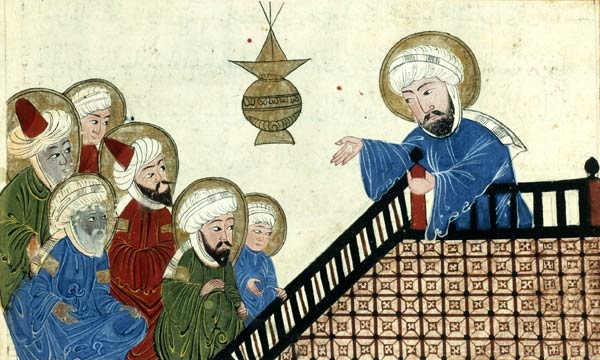
Prophet Muhammad and his followers
| We believe that in the family tree of the Prophet Muhammad there are two generations that duplicate the same people. It is pair of Vladimir–Kubar (Luay–Kaab) and pair Muttalib ibn Manaf – Abd al-Muttalib (Shaybah). In Table No. 1 we took these repetitions into account by reducing the number of generations of Prophet Muhammad ancestors.
The official opinion of historians about period of life of the Prophet Muhammad and the date of death is supported by information that on the day of his son's death there was a solar Eclipse. The Prophet himself died few months after these events. Muslims began to talk about this phenomenon as miracle they say the sun was eclipsed in sadness because of the death of Ibrahim. Muhammad replied that the eclipses had nothing to do with death or the birth of people. It is believed that Ibrahim was born in the last month of 8 years of Hegira in April 630, and died at 21 months of life. It turns out that the son died at the end of 631 or 632 in the beginning of the year. The only Eclipse of the sun, which penumbra concerned Medina, was on January 27, 632 [18, 19], which violates the logic of dating. The only Eclipse of the sun, which penumbra touches the Medina was on January 27, 632 [18, 19] it is Shawwal 28, 10 years of Hegira. The annular Eclipse lasted 1 min 40 seconds and occurred at 06:45 UT or 9:45 o’clock local time, and the width of the shadow was only 78 km and moved along the tip of Arabia at 1100 km South of Medina. Commentators to the Eclipse didn't say it was partial – we are talking about a full-fledged phenomenon, but the Eclipse of January 27, 632 does not meet these parameters.
The study of eclipses of the sun, which occurred in the period of interest to us and passing through the Medina, gave two such events [18, 19]. We are talking about the Eclipse on 7 February, 1152 annular type (A) with the phase of 0.924, 11:15 UT (14:15 o’clock local time), with duration of 9:18 min, the width of the shadow 288 km (107th Saros). The shadow of the moon passed right through Mecca and Medina. The second Eclipse occurred on January 17, 1162 a ring-shaped type (A) with phase of 0.95, at 07:14 UT (10:14 o’clock local time) lasting 5:54 minutes a shadow width of 263 km (98th Saros). The shadow of the moon is passed 400 km to North of the Medina. Therefore, the best way for events suited Eclipse February 7, 1152 (Figure No. 3, [19]) it is Shawwal 28, 546 years of Hegira, which coincides with the date of death in 10 years of Hegira.
On this basis our hypothesis from 2009 about dated the life of the Prophet Muhammad in 1090–1052 [5], finds accurate astronomical confirmation. The second decision is dating 1100–1162. The writing of the Quran the authorship of Prophet Muhammad refers to the period 1130–1152 or 1140–1162. Consequently, the Holy book of Muslims in full form could appear in different regions of the world after copying not earlier than 1170th. It is known that the early lists of the Quran after the approval of the official text of the Book were destroyed.
| 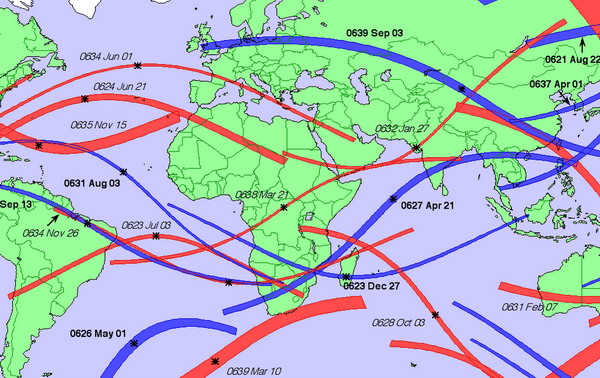
Solar Eclipse period of 620 - 640 (Eclipse of 27.01.632)
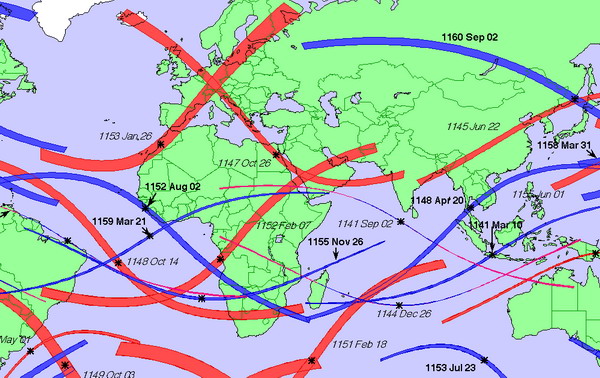
Solar Eclipse period of 1140 - 1160 (Eclipse of 7.02.1152)
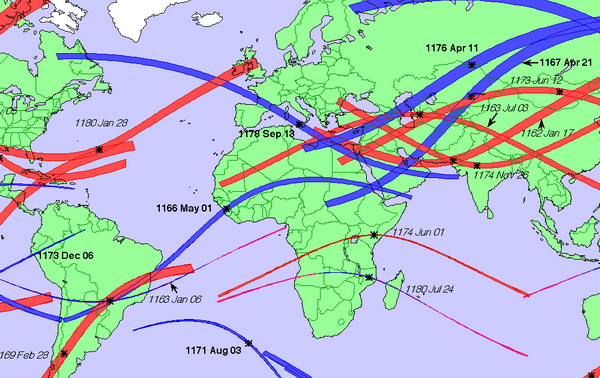
Solar Eclipse period of 1160 - 1180 (Eclipse of 17.01.1162)
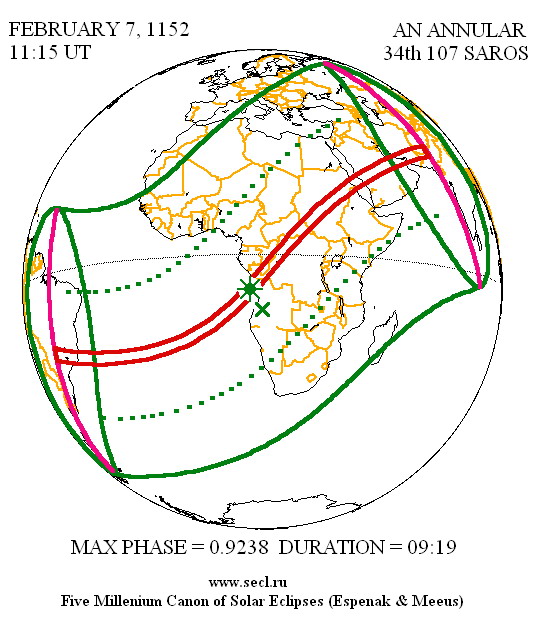
Figure No. 3. Solar Eclipse of 7.02.1152, 107 Saros
| We have reliable evidence of the first use of the Quran to take an oath when enthroning the Kings of Volga Bulgaria in 1178, when the Khan Gabdulla Chelbir (1178–1225), son of Otiak took an oath on the Quran, volume III, p. 59 [8]. The second time was in 1179, volume I, p. 140 [8] during the battle on Bular, when the King swore in the Quran that he would spare the rebels. The third earlier mention is on volume I, p. 168 [8], which corresponds to the time of the reign of the Bulgarian King Gazi Baraj (1229–1246). Note that the Princes of Russia and the Khans of Volga Bulgaria were true Quraysh, the closest relatives of the Prophet Muhammad and his ancestors in Arabia. Doubt in matters of faith the Muslims of Bulgaria does not have, so we make clear conclusion – the Quran was published during the reign of Khan Ulug–Mohammed, son of Shamgon (1164–1178). This fact is confirmed by the information in the comments of Ibn Qudamah [21], who memorized the Quran after 1156, regarding the usefulness of the oath on Quran. It turns out that before the second half of the XII century, no one swore on the Quran.
Prophet Muhammad unfortunately left no male descendants. The ethnicity of the Prophet to the Ugric Kings (Haplogroup N1) was never discussed, as the life of Muhammad was distorted in the Arab Chronicles and his relatives were recorded completely different people in order to increase the authority of respected families. To confirm our hypothesis, it is necessary to conduct DNA study of the hair of the Prophet Muhammad, as well as carefully study the DNA of male representatives of the Sayyid and Hashemite of Saudi Arabia and neighboring countries.
In the Chronological diagram (Figure No. 4) we have summarized the information on the history of Christianity, Islam and Judaism from the Flood (1244 BC) – the Late Bronze Age collapse (1250–1200 BC) to the present day (2020). Originally there was a Pantheon of Olympian gods formed from the Patriarchs of mankind, ethnic Ugrians – the children of Noah and their immediate descendants. They lived many hundreds years, but Noah–Nij–Cronus–Nuh (Biblical, Greek, Vedic and Muslim names) died in 900 BC, and then in 750 BC, died Sam–Zeus–Jupiter, and then in 685 BC the Raphael–Hercules died. People were left without living gods, whose functions began to take over the Pharaohs, Kings and Emperors.
In 7 or 17.11.9 was born Khagan Tash Bash, aka Emperor Titus Vespasian Flavius, aka Biblical Abraham, who created the speculative religion of monotheism – Christianity, associated with the expectation of the arrival of the Savior. In honor of this event, the Romans called the new era the Era of Christianity and attributed it to 9 years earlier than the date of birth of the Patriarch. The first Millennium of the new era was the Era of Old Testament Christianity. After completing his career as Emperor in Rome, the Patriarch retired to the Middle East, where he spent decades. About 150 together with son Constantius Chlorus, aka Khagan Aga Ruja, aka Isaac, built the first Christian Church the Kaaba in Mecca. The name of the Church – Cube/Qub/Kub corresponds to the name of God the Father. The Ugrians also called it Kubar (Cube/Kub – the God of the Sun, Ar – head). Inside the Kaaba were idols as images of the children of God the Father and the Patriarchs of mankind, including Kubar (Hubal) with a golden hand.
In 163 took place on duel Tash Bash and Aga Ruja, they are the aka Abraham and Isaac on the Temple Mount (Qubbat as-Sakhrah) in Al Quds. The right hand of the Angel draw off his father's hand, and Aga Ruja won.
In the III century, was born Constantine the Great, aka Kubar, aka Jacob, Israel or Ya’qub. In 312 he defeated the pagan army of Emperor Maxentius and acquired the Christian symbol Labarum. In 313 it proclaimed Christianity one of the state religions of Rome. In 325 he held the First Council of Nicaea, which adopted the Creed of Christianity.
Around 330 the Equal-to-the-Apostles Helen built Christian Church on Temple Mount. In the same date Constantine the Great declared Byzantium like New Rome. The Emperor became the leader of the Kubanites – Israelis.
In 378 the Exodus of refugees from Old Rome on Akhtuba, or the Biblical Exodus of the Israelites under the leadership of Khagan Arbat, aka Theodosius the Great, aka the Moses. In the winter of 379 Arbat moved refugees from Kuban to Crimea (Sinai) on the ice of the Black Sea. Pursuers in chariots died in the waters of the Sea under the broken ice. January 19, 379 Khagan Arbat proclaimed Emperor and he received the title Leader Moses (Dux Moesiae). The name of the province of Moesia became household name, and monotheists began to call it Moses–Musa.
In the era of the reign of Pharaoh Akhenaten in the early V century in Egypt, an attempt was made to introduce a form of Christianity – monotheism in the form of worship of the Sun God Aton. The new religion did not take root in Egypt.
In the 450th the leader of the Kubanites–Israelis or Eastern Romans – Khagan Attila, aka Theodosius II, aka Aetius, aka Joshua, led the second wave of Exodus, moving with the fighting in the Balkans and Europe, settling refugees on the Promised Land. Historians call those displaced by the Huns and Ostrogoths.
| 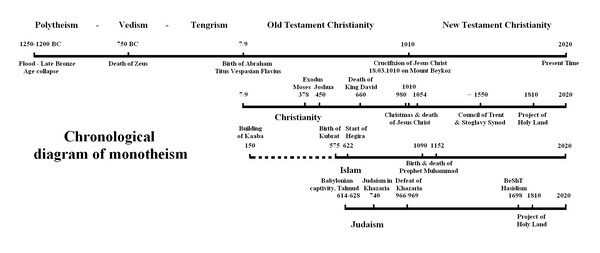
Figure No. 4. Chronological diagram of monotheism
| In 575 was born the Great Khagan Kubrat, aka Heraclius, he is King David (Dad). During his long life – about 85 years, he fought a lot finally defeated the Persians in 628, and created huge monotheistic Empire – Great Bulgaria or Great Israel.
In 614 Al Quds was captured by the Persians, the Church of St. Helena was destroyed, and 35 thousand inhabitants were captured and moved to the capital of the Persians Seleucia–Ctesiphon (Babylon). In captivity (614–628) Semites wrote the Talmud, which became the basis of Judaism. Let us repeat that is no Jesus Christ in the Talmud, he has not yet born.
After the liberation of Al Quds in 626–628, work began on the construction or reconstruction of the Church on the Temple Mount.
In the VII century around the Kaaba began new form an Orthodox branch of Christianity – Islam. Acts of Great Hagan Kubrat – Heraclius prompted the establishment of Islam. Kubrat became the prototype of the Prophet Muhammad of the VII century, later merged in the XII century with the personality of the true Prophet (1090–1152), who wrote the Quran in 1130–1152. The consequence of series of wars Kubrat was the relocation of the supporters of the new religion of Islam from their familiar places from Mecca to Yathrib/Medina in 622. The Hegira date was the first year of the new Islamic calendar, which was put into practice only in 637 by Caliph Umar ibn al-Khattab.
In 650 after the collapse of the Turkic Khaganate in the North Caucasus and the Volga region, the Khazar Khaganate began to form in which Judaism became the main religion in 740. Khanate ceased to exist in 966/969 under the blows of the troops of Prince Svyatoslav composed from army of Russ, Bulgarian and Romans.
In 705–711 Great Khagane Sulabi, aka Justinian II Rhinotmetus, aka Suleyman, aka Solomon, was finished on the Temple Mount the Solomon's Temple or Mosque Qubbat as–Sakhrah. The Christian roots of the first Church, created by Saint Helena, dissolved in the expansion of Islam in the Middle East. The Jews ' claims to the Temple were also ignored as result the real Holy House of God was not recognized by Christians and Jews as its religious building. Now the Jews believe that the Temple of Solomon was destroyed, but it stands in its place in excellent condition since its creation in 711.
In the X century in Damascus Muslim theologians made the first attempts to write the Holy Book of Islam.
In the family of Flavius – Russ Prince Vladimir and Princess Anna in 961/962 was born the Virgin Mary. In 979/980 the Savior Jesus Chrysostom was immaculate born. March 18, 1010 Jesus Christ was crucifixion on Mountain Beykoz in Constantinople during the evening of solar Eclipse. The beginning of the Second Millennium of Christianity coincided with the Era of the New Testament.
At the end of July 1054, the Savior died of old age in earthly life, the event coincided with the explosion of Supernova (Crab nebula). Jesus Christ is buried under the name Confucius in China in the Qufu city.
In 1054 there was a Schism of the Christian Church into Catholic and Orthodox.
In 1096 the First Crusade to Palestine began.
In 1090 was born a true Prophet Mohammed, who joined together his divine revelation, the traditions and the Scriptures of the Muslims into one book – the Quran (1130–1152). In the winter of 1152 the son of Prophet Muhammad named Ibrahim died in infancy. The event was accompanied by a circular solar Eclipse on February 7, 1152. A few months died the Prophet Mohammed, which became for Muslims the integration of the two prominent personalities – Great Khagan Kubrat from the VII century and his direct descendant Muhammad from the XII century.
The first mention of the oath on the Quran during the ceremony of enthronement of the Khan of Volga Bulgaria the Gabdulla Chelbir dates back to 1178.
In 1204 Constantinople fell under the onslaught of the Crusaders, as result of numerous relics of Christianity spread to Cathedrals, Monasteries and Churches in Western Europe.
The next significant date of Islam with Russian specifics was 1312, when the Golden Horde was forced to re-adopt Islam according to the canons of Arab countries and the provisions of the Quran.
In 1453 Constantinople and the Holy Land on the Bosporus were captured by the Ottoman Turks. Christians had to adapt their teaching. To do this, they had the opportunity to convene the Council of Trent in 1545–1563, which performed a large-scale transformation of Scripture and Tradition, imposed a New Chronology and geography of Biblical events. In 1551 in Russia passed the Stoglavy Synod, which was in general supported the new developments.
After the defeat of the Khazar Khaganate, Jews dispersed around the world. Judaism began to take shape, is unacceptable to Christians. The rulers of Europe began to expel Jews from their possessions – in 1290 from England, in 1394 from France, in 1492 from Spain, and in 1742 from central regions of Russian Empire.
The Jews supported the work of the Council of Trent in falsifying the chronology and history of religions (1545–1563). As a result, the Jews received trump cards to strengthen their false authority.
The next important milestone for Judaism became in 1698, when he was born the BeShT (Baal Shem Tov), founder of Hasidism, who settled in the vast of Russian Empire.
The Jews supported an international project of the Holy Land in Palestine, in which the French in 1810 built the Cubiculum (also Cube/Qub/Kub) – the Empty Tomb of Jesus within the Church of the Holy Sepulchre in Al Quds.
Then the XIX–XX centuries were accompanied by an active falsification of the chronology and history of the Israelites – Kubanites of Rome and Europe by the exaltation of the Jews and ascribing to them the kinship of all the Prophets and Patriarchs of monotheism, who were actually ethnic Ugrians (Haplogroup N1).
In the 2000th DNA genealogy began to be actively formed with the advent of tools that can trace the male line of ancestors from son to father up to the Forefather. It turned out that the theory of the Jews about their origin from Abraham is untenable. Genetically male Jews belong to a couple of dozen ethnic groups, which completely refutes Jewish legends. Each country has its own Jews. The Jews turned out to be a people consisting of a random combination of clans and tribes from all over the world. Conclusions of our research: The analysis of historical events and acts of several hundred historical figures of the past confirmed the correctness of the short chronology of Ancient Egypt and the discovered chronological shift of 1780 years ago. The real Patriarchs of mankind were representatives of the family of the Ugric Kings (Haplogroup N1), leading their tree from Adam and his first children, who were born in the Volga region and the Southern Urals. Confirmed the correctness of the hypothesis of Maria Gimbutas and author's research, according to which modern humanity occurred in the area of Yamnaya culture about 5500 years ago. The correctness of the PIE theory and the vector of settlement of the first people from the Volga region are confirmed. The Patriarchs of mankind are identified by us with real historical figures whose deeds have left their mark on the Chronicles of the past. In particular, Abraham is identified with Titus Vespasianus Flavius (Ugric King Tash Bash), Isaac with Constantius Chlorus Flavius (Aga Ruja), Jacob with Constantine the Great (Kubar), Joshua with Attila, King David with Heraclius (Kubrat). The Temple of the Kaaba was erected by Titus Flavius Vespasian (Tash Bash) and Constantius Chlorus (Aga Ruja) about 150. The Temple of Solomon was completed by Justinian Rhinotmetos (Sulabi) in 711 and it still stands on the Temple Mount. Jesus Christ was born in 979/980 in the family of St. Vladimir and Princess Anna, was crucified on March 18, 1010 on mount Beykos (Adam's Head) in Constantinople, as evidenced by the solar Eclipse (94th Saros). The Savior died in China in July 1054 (Supernova flash), his body resting in the Kong Lin memorial in Qufu city. The Prophet Muhammad was born in 1090 and became an integration of the two figure of history – Hagan Kubrat from the VII century and Mohammed from the XII century. The death of the Prophet Muhammad occurred in 1152, as evidenced by the solar Eclipse on February 7, 1152 (107th Saros), which falls on the day of the death of his younger son Ibrahim. Pr. Dr. Valeriy Viktorovich Kubarev. 01–27.08.2019. Bibliography: 1. Gimbutas, M. (1964) Bronze Age Cultures in Central and Eastern Europe. Mouton.
2. Gimbutas, M. (1977) The first wave of Eurasian steppe pastoralists into Copper Age Europe. J. of Indo–European Studies, vol. 5.
3. Gimbutas, M. (1974) The God and Goddesses of Old Europe. 7000–3500 B. C.
4. Gimbutas, M. (1980) The Kurgan wave № 2 (c. 3400–3200 B. C.) into Europe and the following transformation of culture. J. of Indo–European Studies, vol. 8.
5. Kubarev V.V., Vedas of Russ, IP MEDIA, M., 2009. ISBN 9781-93252567-0. Link: | http://www.kubarev.ru/en/content/251.htm
6. Kubarev V.V., Short Chronology of Ancient Egypt, EESA, #6 (46) 2019, Part. 4, pp. 30–58.
7. Kubarev V.V., Localization of Ancient Rome, EESA, #7 (47) 2019, Part. 4, pp. 28–59.
8. Бахши Иман, Джагфар Тарыхи (Летописи Джагфара) Гази–Барадж Тарыхи (Летопись Гази–Бараджа), I – III том. Бахши Иман. Джагфар Тарихы. Свод булгарских летописей 1680 г. / Изд. подготовлено Ф. Г.-Х. Нурутдиновым. Оренбург: Редакция Вестника Болгария, 1993.
9. Sykes, Bryan (2002), The Seven Daughters of Eve, Corgi, ISBN 0552148768.
10. Pliny the Elder, Historia Naturalis, XVIII. 3.
11. Kubarev V.V., Attribution of Rurikovich and Emperors Lecapenos, The report at XXVIII International conference on problems of the Civilization, 26.04.2014, Moscow, RosNoU, link: http://www.kubarev.ru/en/content/402.htm
12. Изход. Болгарская версия писания. Глава 12:39.
13. Socrates Scholasticus (5.26).
14. Ibn Hisham. Ибн Хишам «Рассказанное со слов аль-Баккаи, со слов Ибн Исхака аль-Мутталиба» (утверждается, что это первая половина VIII века). Перевод с арабского языка Я. А. Гайнуллина 2002, Издательский дом «УММА», 2003.
15. The Primary Chronicle. Tale of Bygone Years / Повесть временных лет.
16. Nikone Chronicle, Patriarch's Chronicle.
17. «Патерик Печерский або Отечник», 1902, переиз. 2002, Типография Киево-Печерской Лавры, Киев. «Сказание о Святой Чудотворной церкви Печерской каменной Успения Пресвятой Богородицы», стр. 118-137.
18. Fred Espenak, NASA/Goddard Space Flight Center.
19. Catalogue of solar eclipses. http://www.secl.ru/eclipse_catalog.html
20. Присёлков М. Д., История русского летописания XI—XV вв., СПб, 1996.
21. Ibn Qudamah, Al Mugni, IX/407, 7981.
Article text in Word format:
18308.docx |
|

